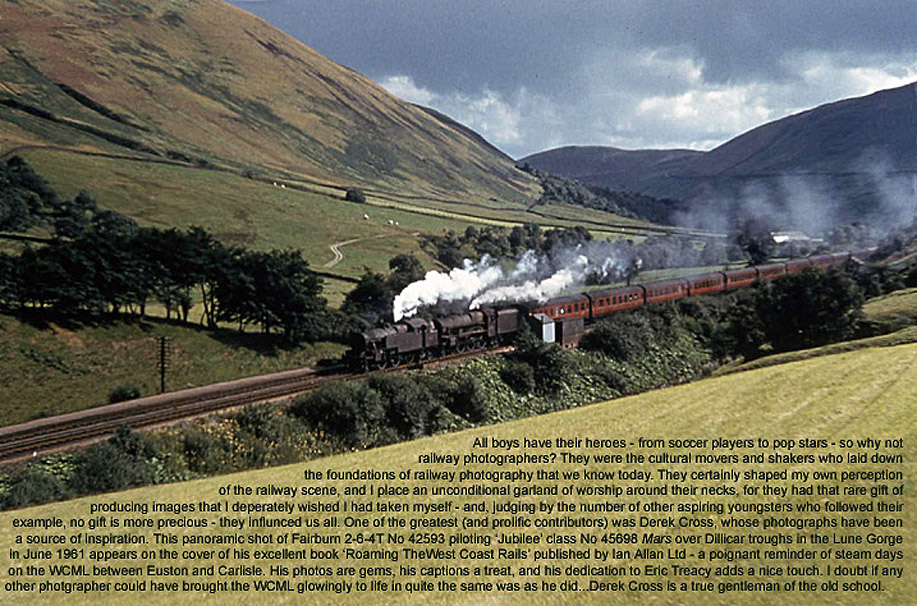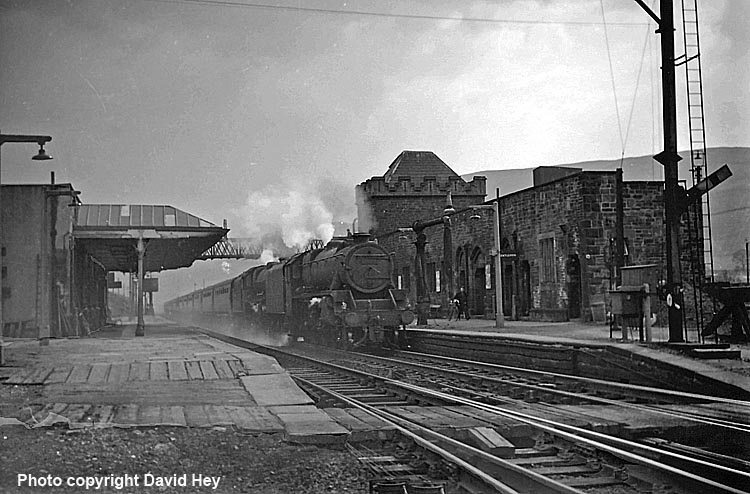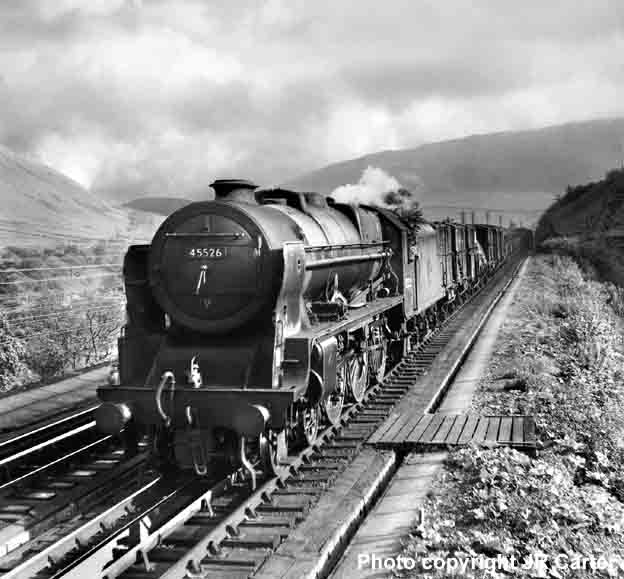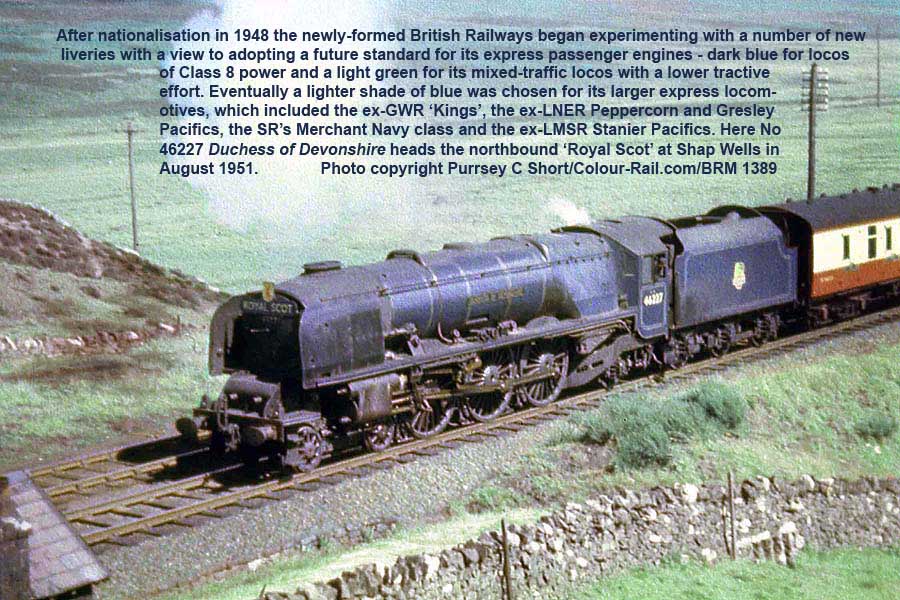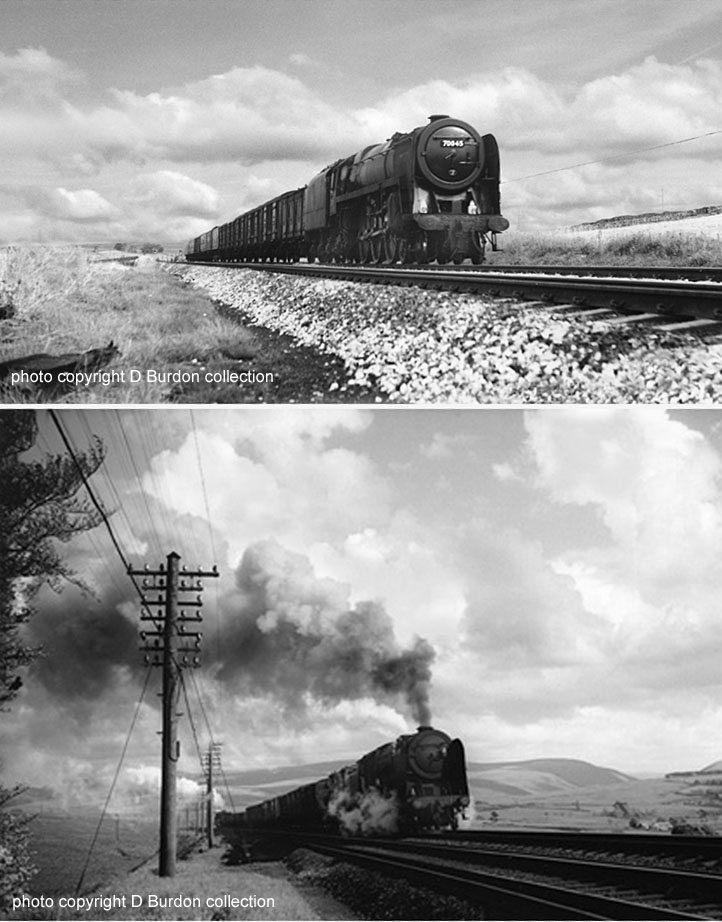In the days before pictorial railway books became all the rage, the photo features that appeared in the monthly railway magazines fuelled the imagination of tens of thousands of schoolboys, who, armed with only the simplest Kodak Brownie 127 camera, became as familiar a feature of the railway landscape as small boys with notebooks and pencils.
I began photographing trains in 1958, but with so precious little money to spend on train fares, my trips with a camera had to be made within affordable travelling distance from Leeds, so I spent most weekends visiting Doncaster and York - both within an hours train ride away. Then, on my 14th birthday I bought a 35mm camera on 'tick' from a mail-order catalogue and what a difference it made.
Being in possession of an expensive-looking Halina 35X camera was the defining moment that changed my early teens because with the typical youthful impetuosity, I no longer wanted to be an engine driver, I wanted to be an official railway photographer, and spurred on by a careers teacher at school, I began 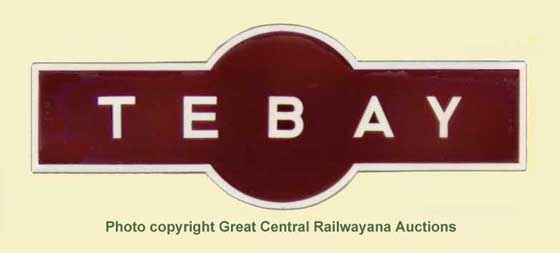 studying the 'Trains Illustrated' and 'Railway Magazine'.
studying the 'Trains Illustrated' and 'Railway Magazine'.
(Inset) An LMS 'Hawkseye' target sign from Tebay station, went under the hammer for £660 at a Great Central Railwayana Auction in January 2010. The GCRA catalogue stated the face had been repainted cream on maroon.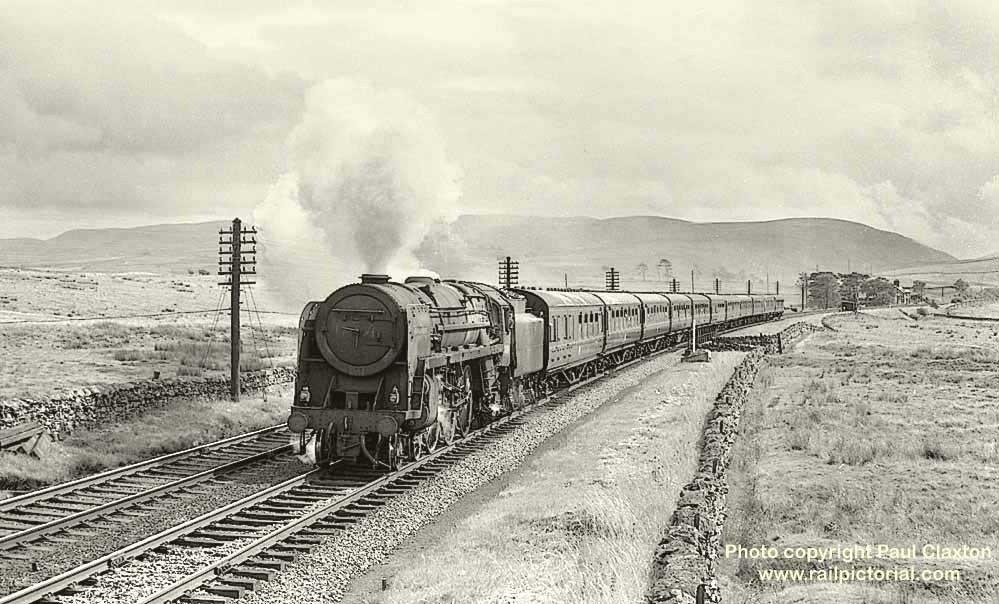
(Above-Below) Shap bank was arguably the most popular venue for railway photographers during steam days. Rising at a steady gradient of 1 in 75 the line reaches the summit at milepost 267½ - a distance of five miles from Tebay. These classic shots of BR Standard 'Britannia' 4-6-2s were taken by the late Paul Claxton with his trusty Kodak Retinette 1B 35mm; the pictorial photo (above) shows the scenery midway between Scout Green and Shap Summit, a good vantage point from where you could observe steam's assault on the bank for miles in each direction. The photograph (below) was taken higher up the bank at Shap Wells, which, in spite of its remoteness, was probably the most photographed location anywhere on British Railways. This is the beauty of Shap Fell; its wide sweeping vistas of moorland and distant peaks are just as popular today with lineside cameramen who flock there to record a steam special. These photos are reproduced courtesy of www railpictorial com - a lovely website created by Mike Claxton in memory of his brother Paul. Details and links can be found further down the page (beneath the map) featuring Paul's reconnaissance with a camera in the Lune Gorge.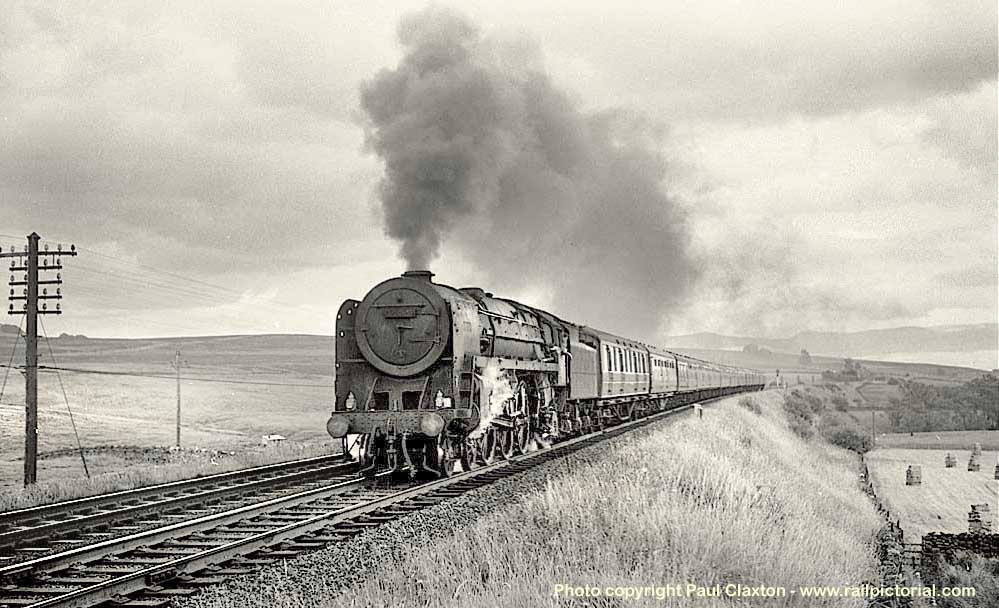
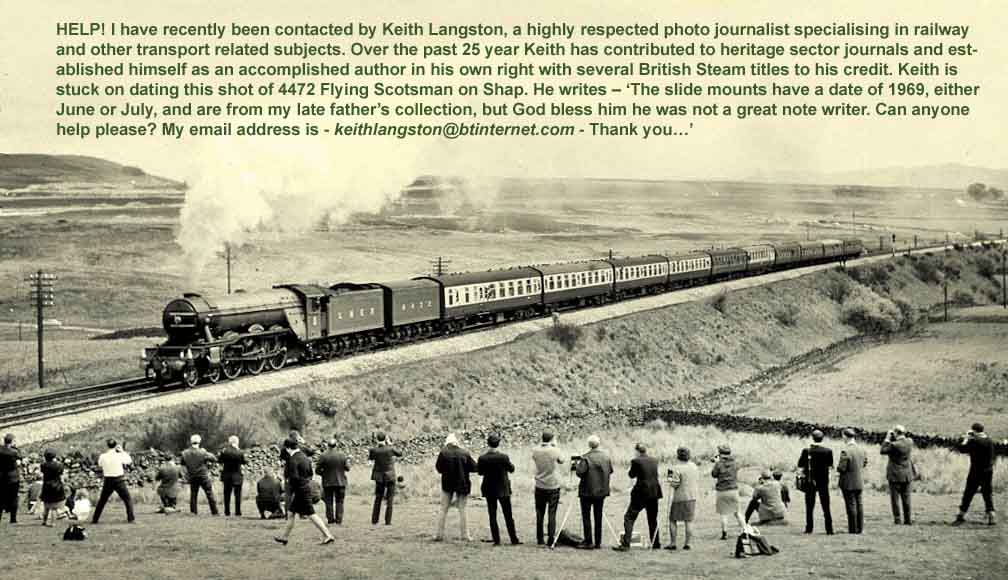
(Above) Pretty as a picture! Derek Cross's landscape shot of Dillicar Troughs is a gem! Halcyon memories of steam days in the Cumbrian Fells.
(Below Left) This is the photo that started it all!
Every picture tells a story, they say, and this was certainly true of Eric Treacy's photographs. My bedroom wall was covered with evocative images of Duchesses and Lizzies captured in the light and shade of Edge 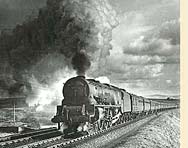 Hill Cutting or slogging over Beattock and Shap. It was almost as if he had glimpsed into my soul and seen all that mattered.
Hill Cutting or slogging over Beattock and Shap. It was almost as if he had glimpsed into my soul and seen all that mattered.
In 1946 the aspiring Ian Allan Company published a number of booklets 'ABC Locomotive Series' featuring 'My Best Railway Photographs' taken by such luminaries as Maurice W Early, CCB Herbert and, of course Canon Eric Treacy.
In pride of place on my bedroom wall was this classic shot of 6230 Duchess of Buccleuch on the 'Royal Scot' at Shap Wells. It appeared in the first book of the series, in which Eric Treacy writes...
'This was a stormy day in March. My wife and I had walked from Shap to Haweswater for lunch, with the intention of getting back to Shap by 3.30pm to be in time for the 'Scot'. Unfortunately I miscalculated the time, and I had to run the last two miles! I was nearly winded when I arrived beside the line; fortunately I was not carrying either of my heavier cameras, but was using the Super-Ikota camera. The train had arrived before me, and was standing 'blowing off' irritably at a signal about 300 yards way. So I had time to get my breath and set my shutter before she started to move. Doubtless I was more pleased than the driver that the train had been stopped, for when she passed me the 'Duchess' was on full regulator and chucking up a really magnificent cloud of exhaust; and mirabile dictum, the sun came out for the crucial moment! Five minutes later I was sheltering from a violent hail storm. No one who knows Shap will be surprised at that!'
It's small wonder that this youngster longed to visit Shap and see it for himself.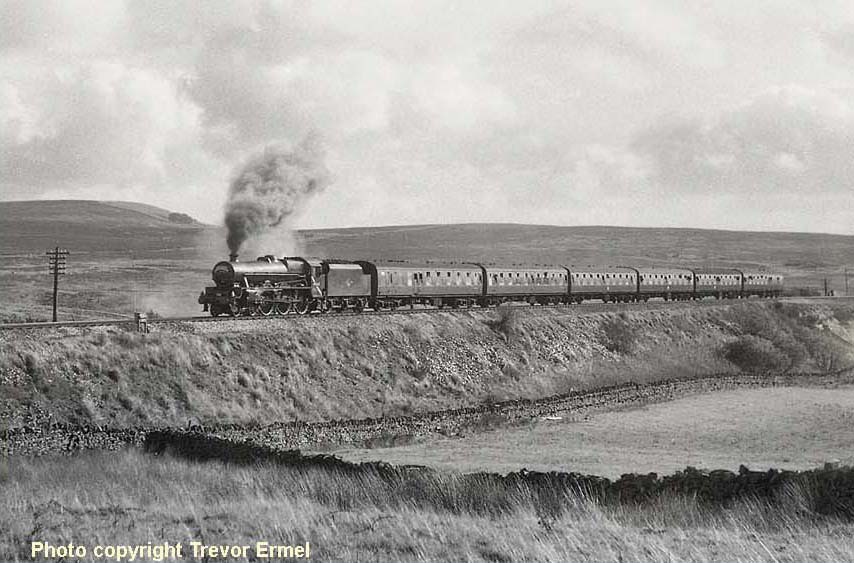
(Above-Below) With the demise of steam gathering pace during the late Sixties, 'Jubilee' class No 45562 Alberta had become something of a celebrity locomotive. Based at Holbeck Shed, Leeds (55A) it was one of only a handful of remaining 'Jubilees' and was kept in very presentable external condition, mainly due to the unofficial efforts of enthusiasts eager to have a clean engine for their 'master shots'!
This photo of Alberta was taken by Trevor Ermel (see Trevor's excellent 'Rail Cameraman' Page 69) when the loco worked the 'South Yorkshireman' Rail Tour from Bradford to Carlisle on 7th October 1967. The journey north was captured from the popular Shap Wells viewpoint when the fireman had evidently just put on a round of coal, judging by the sudden appearance of smoke from the chimney.
(Below) The best place to see southbound trains was from the grassy embankment overlooking Dillicar Water troughs, just beyond Tebay station. Here 'Britannia' No 70039 (Sir Christopher Wren) is picking up water at the head of a Glasgow to Liverpool express, the 16.25 from Carlisle.
Trevor Ermel writes - 'A chime whistle through the station announced the approach of the train before it burst in to view below the road bridge, steam streaming from the safetly valves; a white cascade erupted from beneath the tender as the water scoop hit the troughs, and we had a fleeting impression of steam and flying spray as the train swept past, faces grinning from the leading coaches, and was gone. For a few seconds, before the spell was broken, no-one spoke word; then we checked our cameras ready for the next performance, as the water troughs gurgled and began to refill...'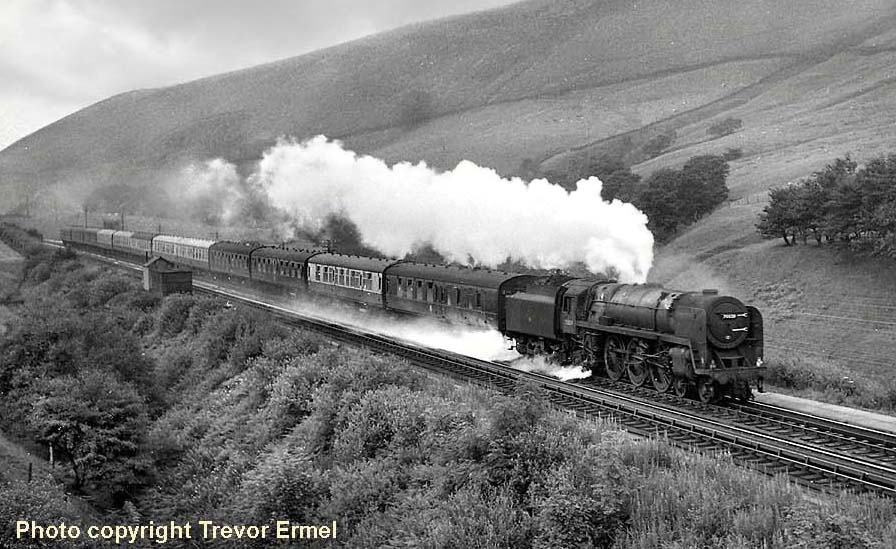
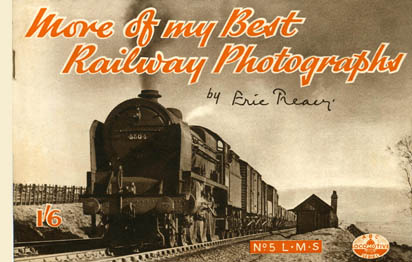 (Right) The cover of No 5 in the 'ABC Locomotive Series' of booklets series shows Eric Treacy's shot of 'Patriot' class No 5504 Royal Signals on a goods train, making heavy weather on the gradient in 1947.
(Right) The cover of No 5 in the 'ABC Locomotive Series' of booklets series shows Eric Treacy's shot of 'Patriot' class No 5504 Royal Signals on a goods train, making heavy weather on the gradient in 1947.
In his brief introduction he writes...
'April 16th 1947...I visited Scout Green in the evening, and met once again Signalman Ratcliffe, who passes the time between trains with an enormous and high powered telescope - so powerful that he claims to be able to spot foxes on the fells 10 miles away. He was a sniper on the Somme in the 1914-18 war, and told me of a particularly good if gruesome 'hide' which he found for himself in a pile of dead in No man's Land. He claims to have spent several profitable days amongst these pleasant surroundings! It was a beautiful evening, marred only by the sight of a large number of dead sheep on the fells - the result of the severe winter.'
I love the photo, but uncertain about the caption!
(Above-Below) Here are a couple of long-forgotten 35mm shots of steam days once deemed unworthy of printing...thank godness for the digital age! To think of the dozens of negatives like these have been abandoned at the bottom of a drawer for fifty-odd years! (Above) Stanier 'Black 5' pilots a 'Jubilee' class through Tebay station at the foot of Shap Bank. (Below) In the opposite direction 'Black 5' No 45348 coasts past Tebay No 1 box with an 'up' freight
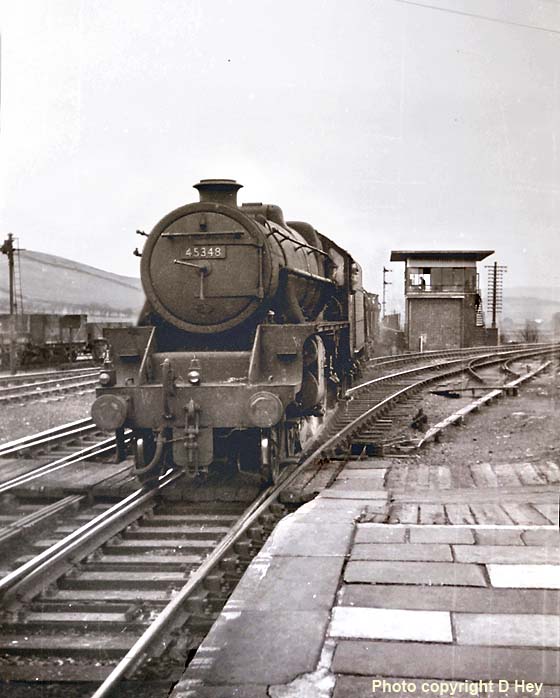
(Below) A classic shot and a superb location, despite an overcast sky. Vintage memories are recalled in this photo of HG Ivatt's Co-Co twins Nos 10000/1 powering a rake of carmine and cream coaching stock through the Lune Valley in the early Fifties (note the nose-end connecting doors in the open position between the units). In February 1953, the Ivatt twin Co-Cos were transferred to the SR for evaluation against the SR/Bullied Ico-Co1s at Nine Elms shed. They returned to the LMR in 1954 working Anglo-Scottish trains in mutliple and singly on freight between Camden and Crewe. The Co-Cos spent long sojourns at Derby for attention caused by problems with spares for the EE Co Mk 1 engine then out of production, and this severely prejudiced the attitude toward the pair. At the same time, ample supplies of the new EE Co Type 4 (Class 40) were beginning to appear on the WCML and the pioneer diesels became surplus to requirements. Photo © GEC/Alstom
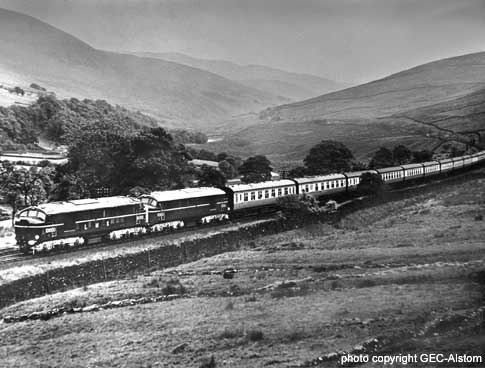
But Eric Treacy wasn't the only member of the old school to have influenced me. Most enthusiasts will recall the classic steam photos by Derek Cross - a name synonymous with train spotters. His pictures appeared in almost every edition of the 'Trains Illustrated' and 'Railway Magazine' and my only aim in life was to try and copy him.
Of course, being driven to emulate your hero is a blessing - as long as you know where you are going - and in many ways I reconcile myself with the thought that I had a chance to record the miasma of steam's demise in the 1960s before it was too late.
As for visiting Shap? I longed to go there, but the cost of a cheap day return from Leeds to Tebay (via 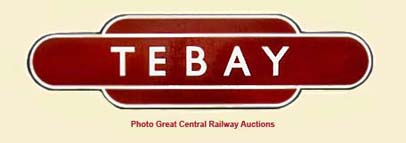 Carnforth) was more than the miserly wages I earned from my morning round each week so it was impossible... unless I could persuade my dad to sub me a couple of quid?...
Carnforth) was more than the miserly wages I earned from my morning round each week so it was impossible... unless I could persuade my dad to sub me a couple of quid?...
Not unexpectedly, my dad flatly refused! - 'There are certain things in life that are worth waiting for,' he said - and, as it turned out he was right! A few weeks later, I heard about a Cheap-Day Ramblers Excursion from Leeds to Tebay on Sunday, April 18th 1960, which, for this starry-eyed youngster, was a dream come true.
When the big day arrived, it didn't matter that the excursion was headed the scruffiest 'Black Five' No 45306, or that the outward journey seemed to take an age - first picking up ramblers at intermediate stations all the way to Skipton, then dropping off at every station to Tebay. At least it gave me a chance to photograph No 45306 at the stops we made at Clapham, Ingleton, Kirby Lonsdale, Sedbergh and Low Gill - five shots in all, plus a sixth I took from the carriage window of a Class 8F No 48283, Black 5 No 45153 and a Class 3F Johnson Midland rebuild No 43585 simmering in the shed yard at Hellifield…six out of 24 exposures - 18 left.
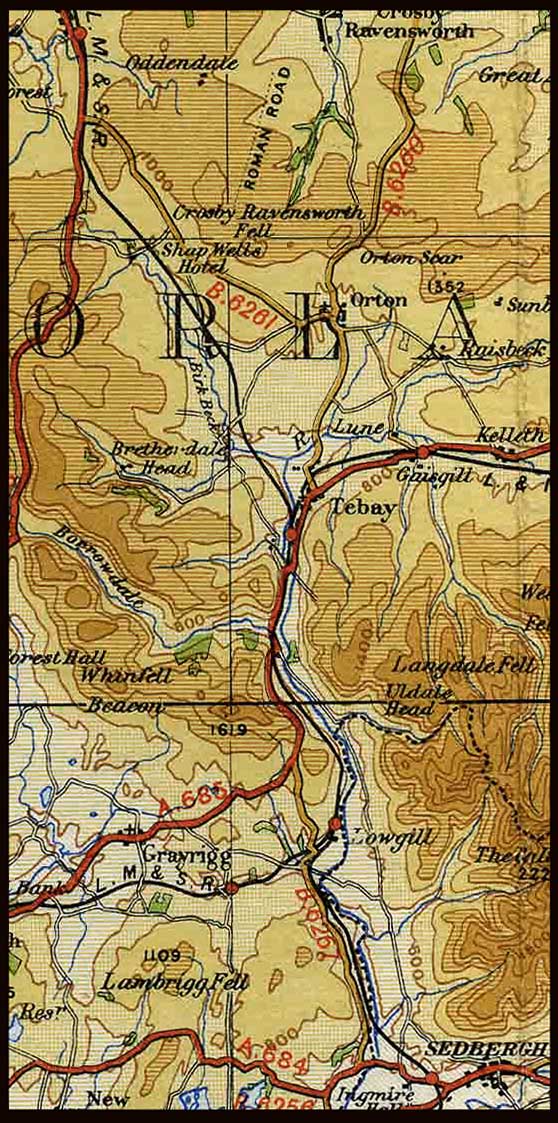
(Above-Below) A section of a favourite cycling map from the early 1960s - an Ordnance Survey Quarter-Inch cloth-bound Map of England, North Central, costing the princely sum of Three Shillings & Ninepence...more than I earned from my morning paper round each week, but worth every penny. It was a constant companion inside the zipped-up breast pocket of my anorak, and I still have it today - the map, not the anorak...the colourful contours of the Lake District mountains and the Yorkshire Dales look so inviting! (Below) A Carriage Print in its original glazed frame - 'The Lune Valley near Tebay, Westmorland' - by Greene went under the hammer for £40 at a Great Western Railwayana Auction in May 2008.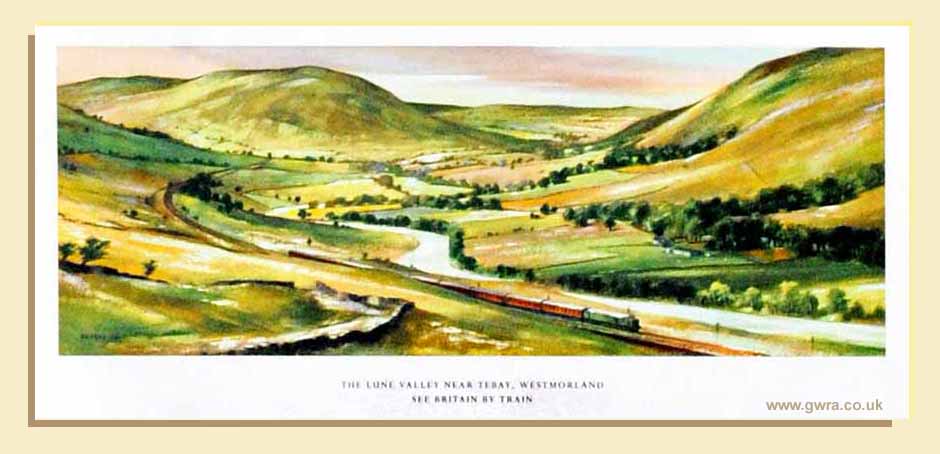
(Below) With Langdale Fell dominating the horizon, this tantalizing glimpse of the distant peaks flanking the Lune Gorge is captured by master cameraman, Paul Claxton, as a BR Standard 'Clan' 4-6-2 heads north between Grayrigg and Low Gill. Paul's photos have been scanned by his brother, Mike, with a view to displaying the images online, however in view of the enormity of the task - currently standing at more than 7,400 photos - it will take some time before it is finished...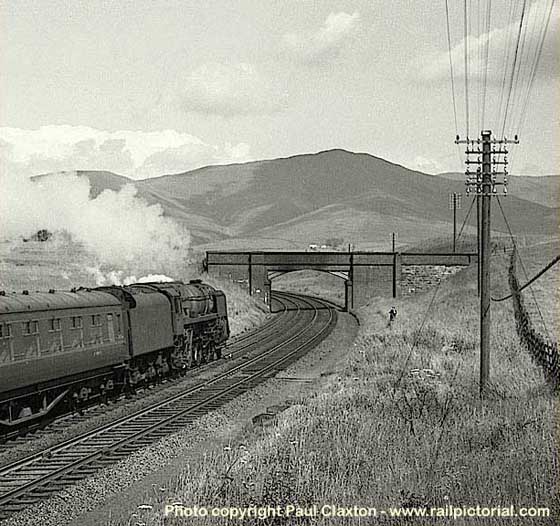
THE PAUL CLAXTON COLLECTION
The Lune Gorge
Mike Claxton's superb ww.railpictorial.com website is dedicated to the memory of his brother Paul, who sadly passed away in April, 2009. Paul started train spotting at a very early age, and like most young boys  during the late 1950s he began taking railway photographs, a natural adjunct to train spotting.
during the late 1950s he began taking railway photographs, a natural adjunct to train spotting.
Mike has created the website so that enthusiasts can enjoy his brother's remarkable photo collection online…and what a collection it is! There are just not enough accolades to describe the quality of Paul's photographs for his reconnaissance with a camera in the Lune Valley during the 1960s reminds me of my own visits to this lovely spot, except I didn't get anything quite like this! His photos simply take my breath away...
Needless to say, I'm a big fan and I'm sure you will be too after you've visited the LMR pages on the site here. However, I would strongly suggest you 'bookmark' it or mark it a 'favourite'. I'm saying this because there are over 7,800 images - a lot to absorb in one visit, and I fear you might get lost in a twilight world of nostalgia and never come back! 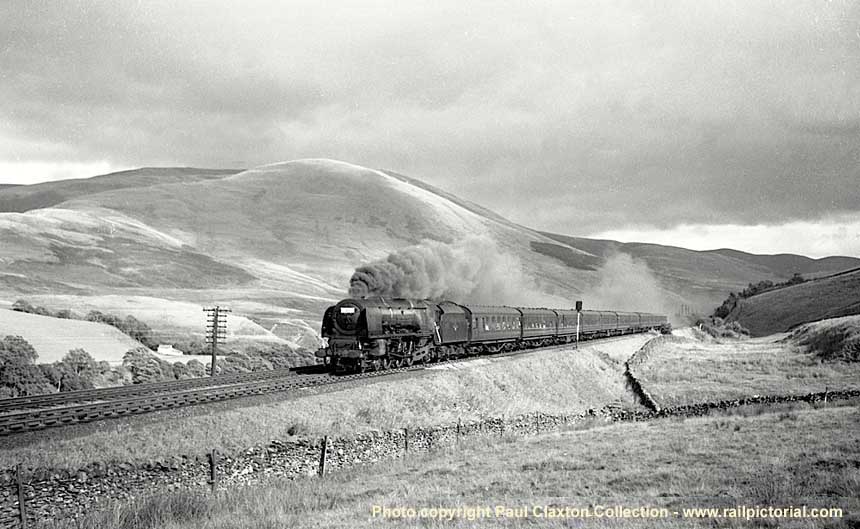
(Above) Stanier 'Duchess' class Pacific No 46254 City of Stoke-on-Trent heads a Euston-Glasgow express through the Lune Gorge on 1 August 1964.
Historically the gorge has provided a vital transport link since Roman times. Surrounded by the broad northern flank of the Howgill Fells and the Birbeck Fells to the west, this dramatic valley was considered the natural choice of a route for the London and North Western Railway's Lancaster to Carlisle line. At the time, the company's most eminent early civil engineers were Robert Stephenson and Joseph Locke, albeit both men had very different ideas on how to build a railway; Stephenson's preference was based on the premise that the shortest distance between two points was a straight line, and as a result several impressive memorials in one form or other still remain today, most notably the bridges he built on the line from Chester to Holyhead.
(Below) Royal Scot class 46128 The Lovat Scouts heads the 1M30 Glasgow to Liverpool relief on 13 July 1963. 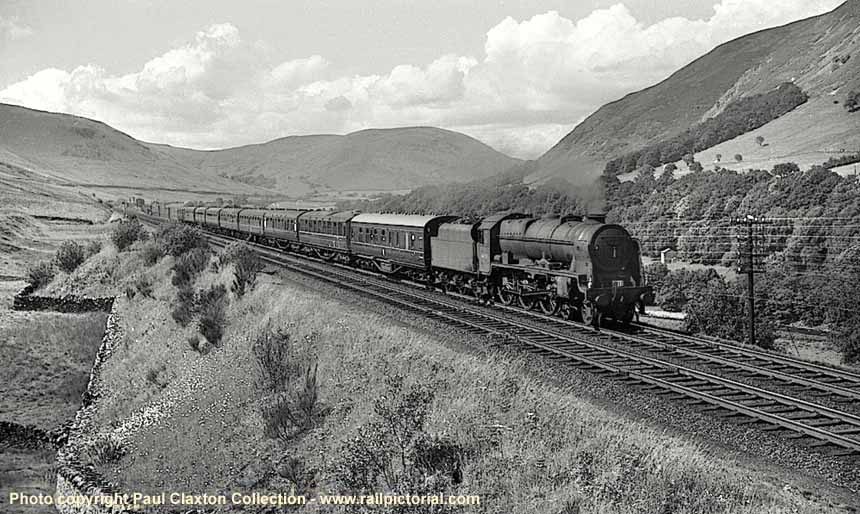
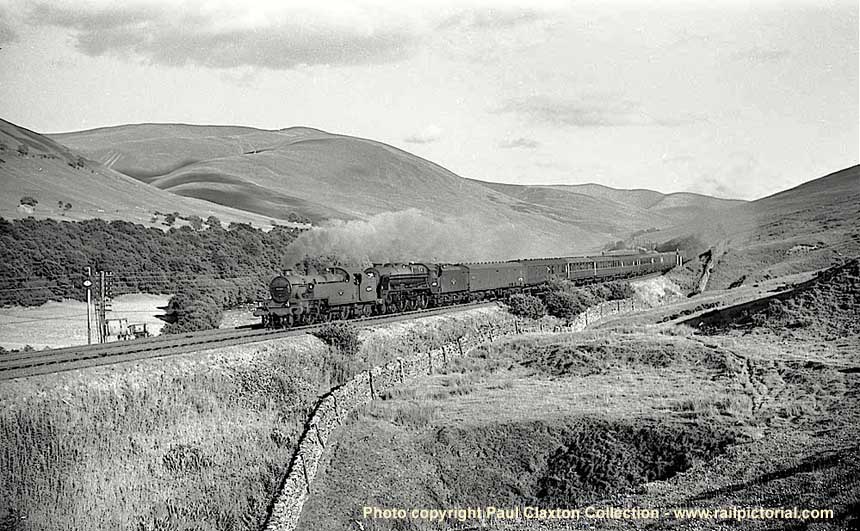
(Above) Fowler 2-6-4T No 42319 pilots Rebuilt 'Patriot' class No 45530 Sir Frank Ree on the 1S80 London to Glasgow on 13 July 1963. The provision of a pilot engine, or double-heading a train between Oxenholme 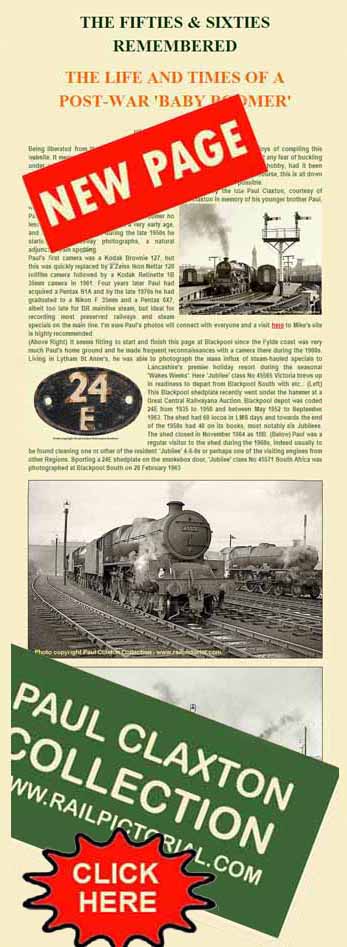 and Shap, is mentioned in Derek Cross's book 'Roaming the West Coast Rails', in which he writes - 'Put a sock on it' was the local term for a train that was piloted from Oxenholme to Shap Summit. The origin of the term is wrapped in mystery but knowing the railwaymen of the district it is probably rude!'
and Shap, is mentioned in Derek Cross's book 'Roaming the West Coast Rails', in which he writes - 'Put a sock on it' was the local term for a train that was piloted from Oxenholme to Shap Summit. The origin of the term is wrapped in mystery but knowing the railwaymen of the district it is probably rude!'
When Joseph Locke was appointed engineer of the Lancaster to Carlisle line, he was faced with an uphill task (quite literally) of getting the line over the northern fells. Several routes were considered, including the present-day route along the flank of the hills east of Kendal into the Lune Gorge as far as Tebay, but at this point it was proposed to excavate a tunnel under Orton Scar into the Eden Valley near Appleby. Another option was via Kendal up Longlesdale, followed by a tunnel under the Gatescarth Pass and then along the shore of Haweswater to Penrith. But these proposals were rejected by Locke, who preferred using the natural contours of the landscape, rather than being mired in costly earthworks such as tunnels, even if this entailed longer distances or indeed stiffer gradients.
Nevertheless his choice for building a line over Shap was considered somewhat odd given the small size of locomotives at that time. In steam days, a train climbing the four mile gradient at 1 in 75 to Shap summit required about a half a ton of coal and 750 gallons of water, and since all heavy trains required assistance up the bank, the company would have to provide a stabling point for banking engines, which is how the railway hamlet of Tebay was born.
(Below) The now-preserved 'Royal Scot' class 4-6-0 No 46115 Scots Guardsman heads the 1M31 Aberdeen-Manchester through the Lune Gorge on 13 July 1963.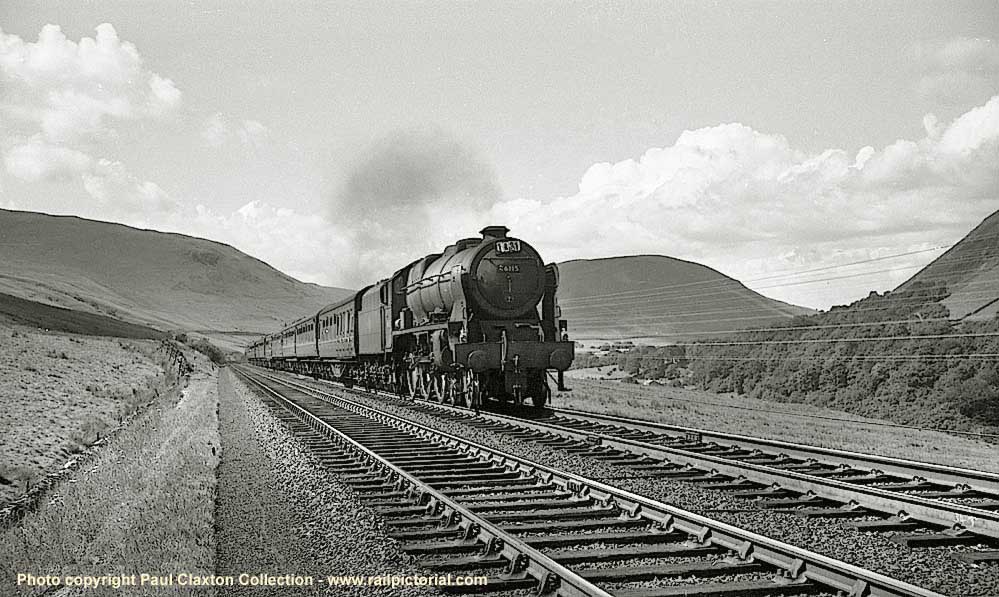
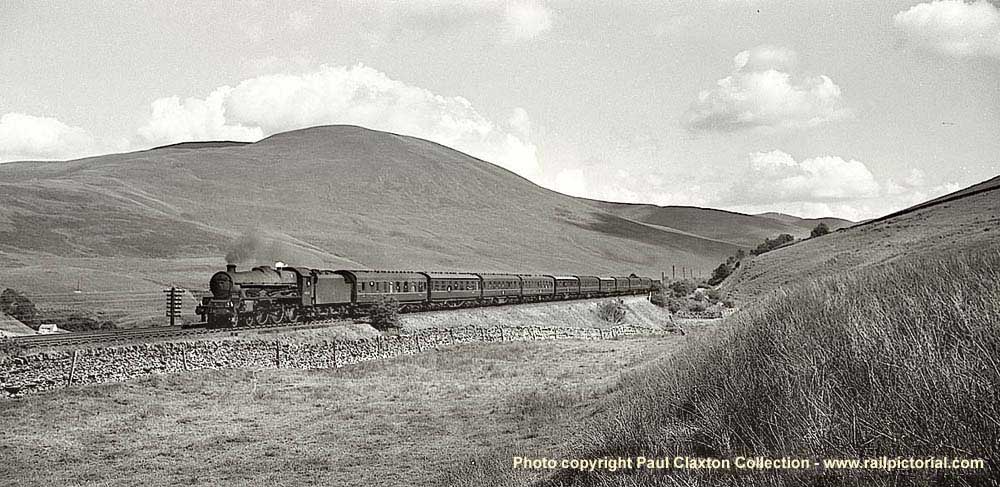
(Above) With the rounded mass of Blease Fell dominating the background, 'Jubilee' class No 45601 British Guiana heads the 1S71 Manchester to Glasgow on 13 July 1963.
Of course, the scenery is what made Tebay such an attraction for photographers...the hustle and bustle of the steam shed, the 'whistling up' of banking engines in readiness for the assault of Shap, but for many photographers, the spectacular scenery to be found in the Lune Gorge was the biggest draw of all.
Indeed before the M6 Motorway arrived, the Lune Gorge south of Tebay was widely regarded as the most beautiful stretch of the West Coast Main Line. The gorge cleaves through a geological fault line in the band of hills connecting the Cumbrian Lake District fells to the west with the Pennine hills to the east.
Alas the motorway has completely ruined the peace and tranquillity of the valley. Okay it may have created opportunities in relation to tourism and economic development, but if you take into consideration its huge scale (six lanes of constant moving traffic - plus the amount of noise associated with it) well, it's just not the same anymore. I suppose one has to accept that progress comes at a price!
(Below) This splendid panoramic view of the valley shows 'Black 5' No 45323 heading a lengthy freight on 13 July 1963.
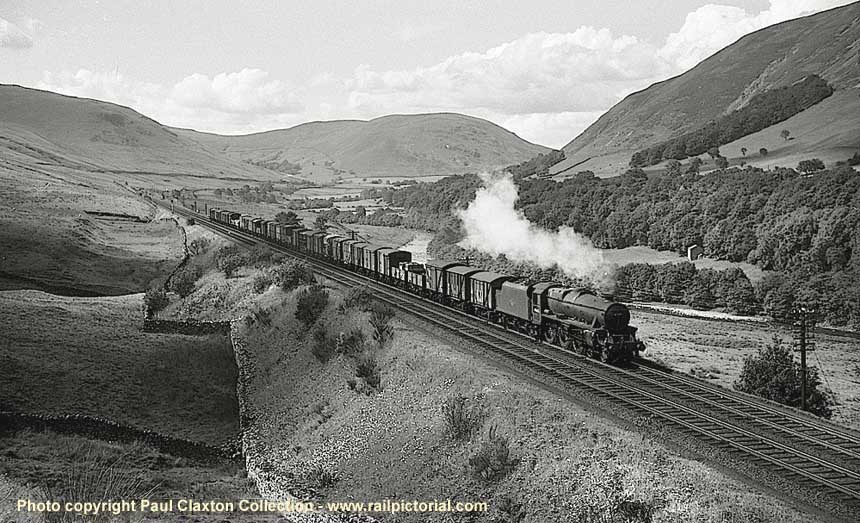
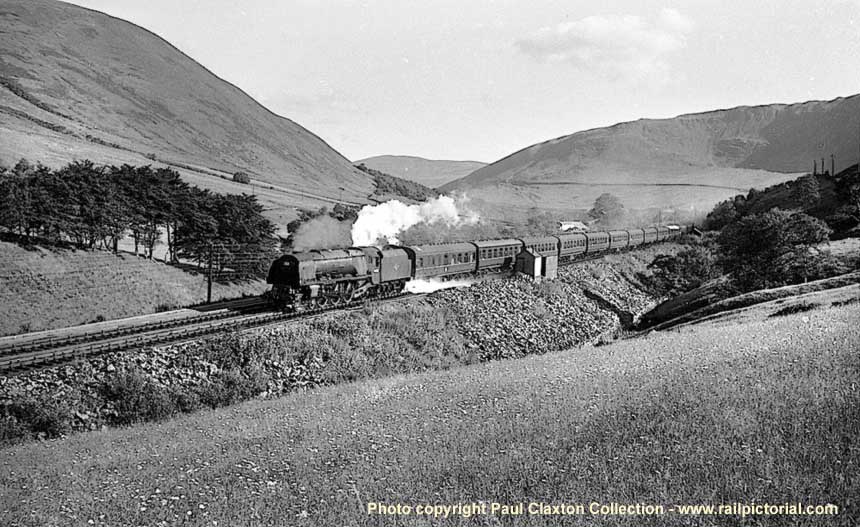
(Above) Stanier 'Duchess' No 46238 City of Carlisle skims over Dillicar troughs with a northbound train.
After the climb north from Oxenholme to the first summit of Grayrigg Bank, the line then heads more or less on a level course through Low Gill into the Lune Gorge, but unlike the new motorway which follows the contours of the valley, Joseph Locke laid a mile of straight track, known to footplatemen as the 'Fair Mile'. A sweeping curve at the northern end heads towards Dillicar water troughs, which for sheer splendour had a setting without parallel anywhere in the British Isles. This length of track was well known to serious students of railway photography, with trains picking up water at high speed following the descent from Shap or making a charge for the bank at full throttle.
(Below) 46245 City of London splashes over Dillicar troughs with the northbound Lakes Express on 13 July 1963.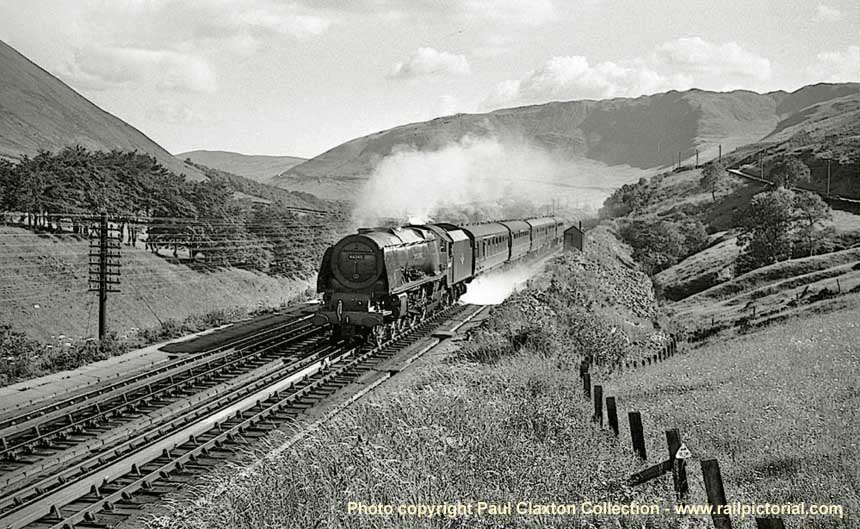
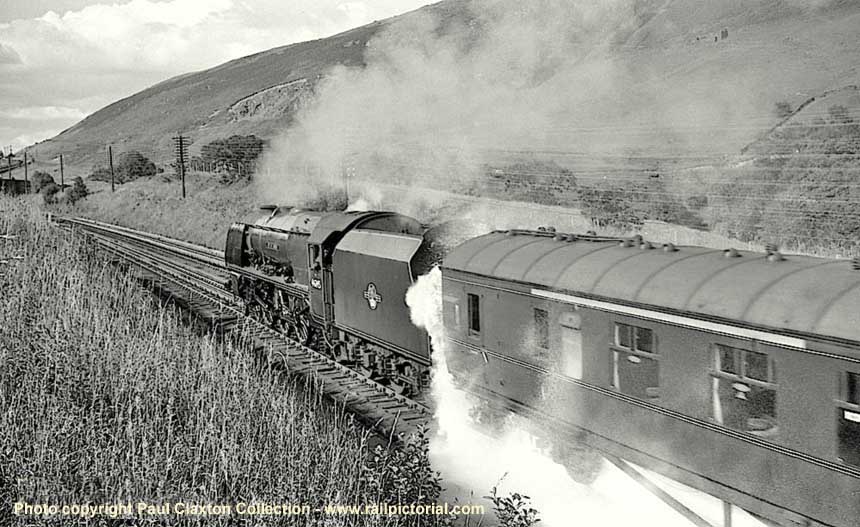
(Above) This is the obligatory 'going way' shot that serious rail cameramen felt compelled to take during steam days, though rarely did we to get anything quite like this! The firemen will be furiously winding up the scoop as water cascades down the side and in all probability filling up the corridor of the leading coach too judging by the open window!
Paul's first camera was a Kodak Brownie 127 in the late 1950s, but this was quickly replaced by a Zeiss Ikon Nettar 120 rollfilm camera followed by a Kodak Retinette 1B 35mm in 1961. He acquired a Pentax S1A in 1965 and by the late 1970s he'd graduated to a Nikon F (35mm) and a Pentax 6X7 (Medium Format), albeit too late for BR mainline steam which ended in 1968, but ideal for recording most preserved railways and steam specials on the main line.
(Below) Paul was taking something of a risk here! Trackside photography in close proximity to water troughs was just asking for trouble, but as luck would have it this 'Jubilee' class 45613 Kenya is picking up water in a more sedate fashion, otherwise his newly acquired Kodak Retinette 1B would have been on the receiving end of a good drenching!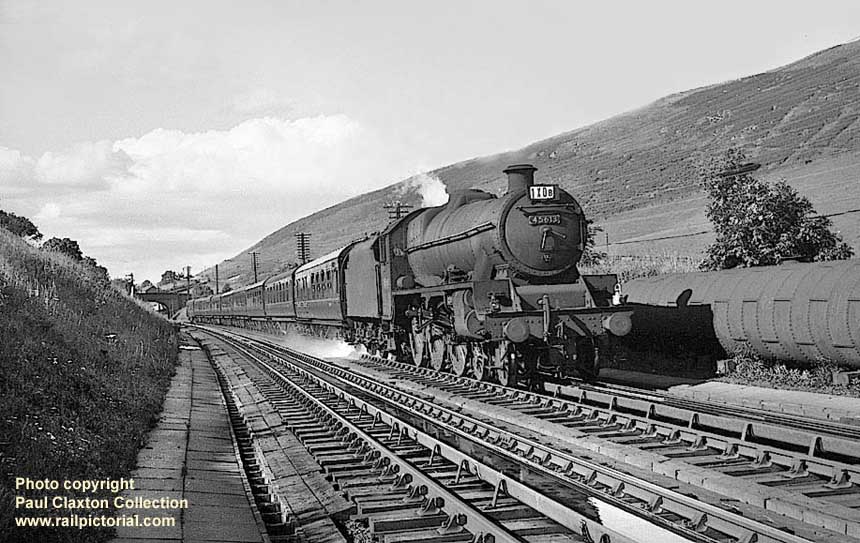
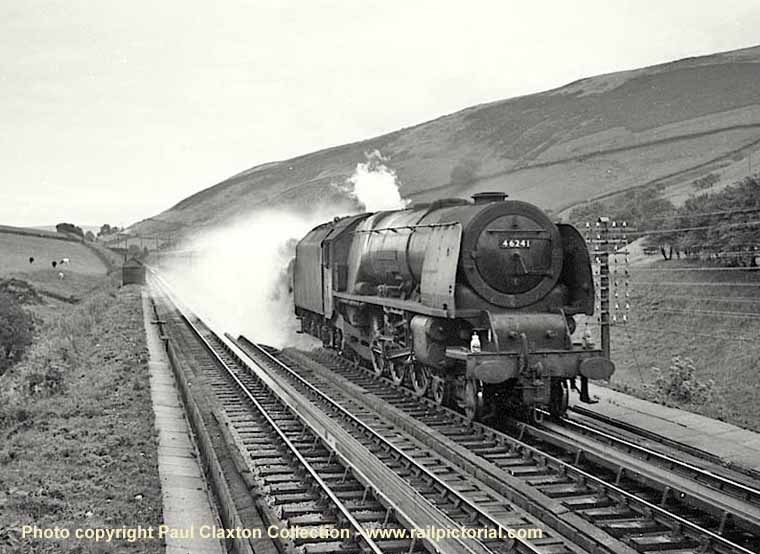
(Above-Below) Not so lucky in this case, though! Stanier Pacific 46241 City of Edinburgh is about to give Paul a good soaking as it heads the 1M37 12.20 Perth-Euston on 6 September 1963. (Below) Leaving the gorge at Low Gill an unidentified 'Britannia' heads the 1M21 Saturday Glasgow-Blackpool at Low Gill; the banner signal shows the route is set for the main line, the lower banner indicates the junction with the Ingleton Branch. The opening of the MR Settle-Carlisle line relegated this North Western Railway route to the main line that never was; it ran from Clapham Junction through Ingleton, Kirkby Lonsdale, Barbon, Middleton-on-Lune and Sedbergh before joining the West Coast main line at Low Gill. Passenger services ceased on 30th January 1954, but the line remained open until 1967.
To give credit where it is due, Mike Claxton has worked hard in creating this website for the simple reason that it gives enthusiasts a chance to enjoy his late brother's photographic collection online. It is an enormous task, and with only one pair of hands and not enough hours in a day, it will take some time before it is complete...nevertheless a visit is a must! However, should you download copies of any of Paul's photographs from this page then it would be appreciated if you would make a donation to the Trinity House Hospice, Blackpool who cared for Paul in his fight against cancer. A click-on link is available here...it only takes a couple of minutes!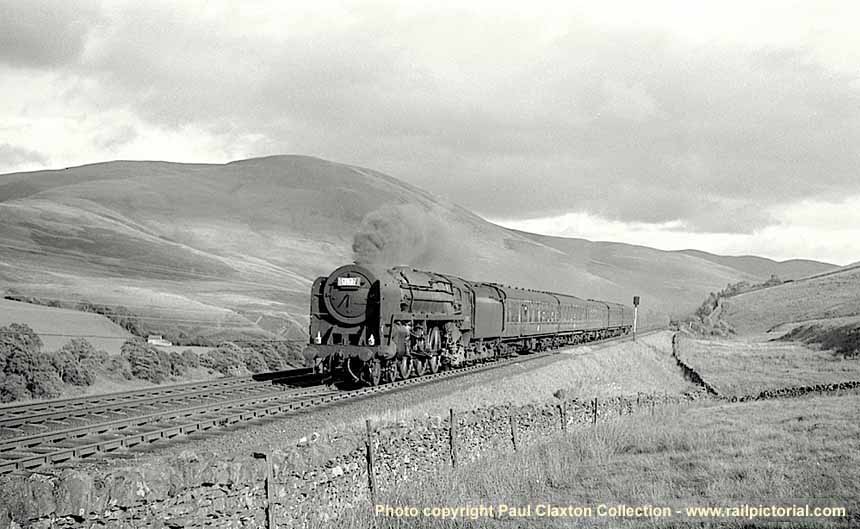
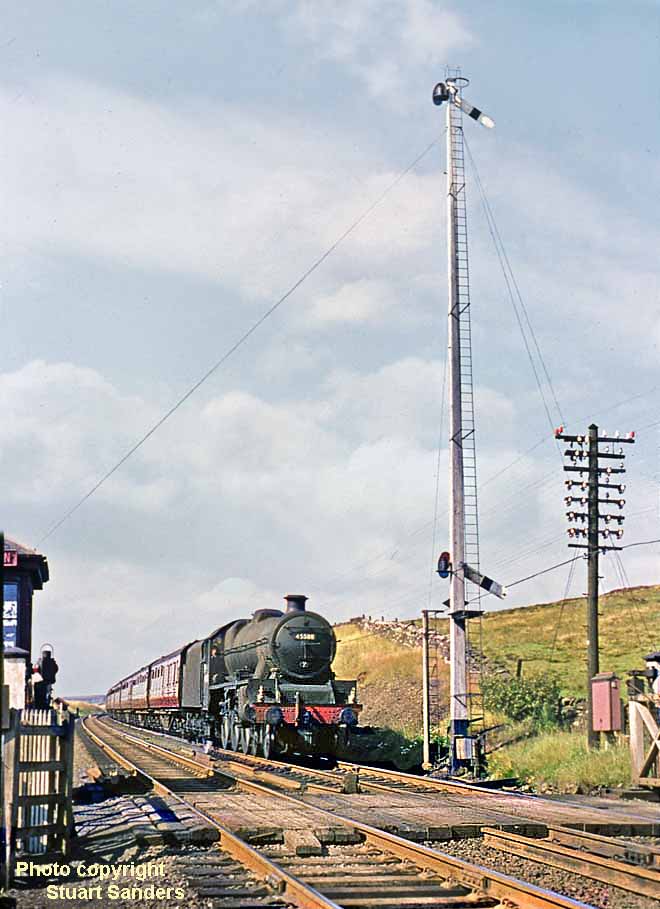
(Below) Memories of steam days in colour...this lovely shot was captured by Richard S Greenwood during the late afternoon of Saturday 27 July 1963; it shows 'Black 5' No 45254 in need of banking assistance with a heavy northbound freight on Grayrigg Bank just north of Oxenholme. More colour shots of steam in the North-West can be found on Richard's 'Rail Cameraman' page 53 'Up North in Colour' here.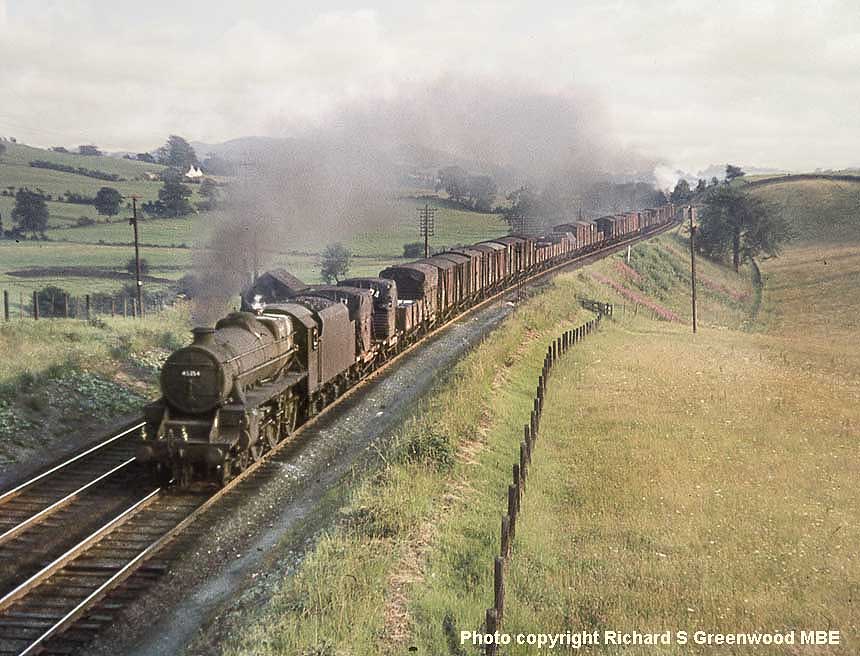
 (Right-Below) A BR London Midland Region maroon enamel signal box nameboard from the London and North Western Railway's Lancaster and Carlisle section of the West Coast Main Line recently went under the hammer at a great central Railway Auction for £1,550. The sign measures 24" x 8", with excellent colour and shine, a couple of tiny chips only, and came from the station box just short of the summit...however yet another BR London Midland Region nameboard (measuring 72" x 12") from the actual 'Shap Summit' signalbox, perhaps the most famous box along the entire length of the WCML, went under the hammer to a lucky bidder for a massive £13,400 in July 2009. Of course, the difference in price has nothing whatever to do with size...it's comparable to buying property - location, location, location!
(Right-Below) A BR London Midland Region maroon enamel signal box nameboard from the London and North Western Railway's Lancaster and Carlisle section of the West Coast Main Line recently went under the hammer at a great central Railway Auction for £1,550. The sign measures 24" x 8", with excellent colour and shine, a couple of tiny chips only, and came from the station box just short of the summit...however yet another BR London Midland Region nameboard (measuring 72" x 12") from the actual 'Shap Summit' signalbox, perhaps the most famous box along the entire length of the WCML, went under the hammer to a lucky bidder for a massive £13,400 in July 2009. Of course, the difference in price has nothing whatever to do with size...it's comparable to buying property - location, location, location! Back in the early Sixties, 35mm film was precious, so I decided to save the rest for Shap - but I never got there. On the final leg of the journey between Low Gill and Tebay, the remote beauty of the Lune Valley looked majestic, so I abandoned any plans for roaming the
Back in the early Sixties, 35mm film was precious, so I decided to save the rest for Shap - but I never got there. On the final leg of the journey between Low Gill and Tebay, the remote beauty of the Lune Valley looked majestic, so I abandoned any plans for roaming the 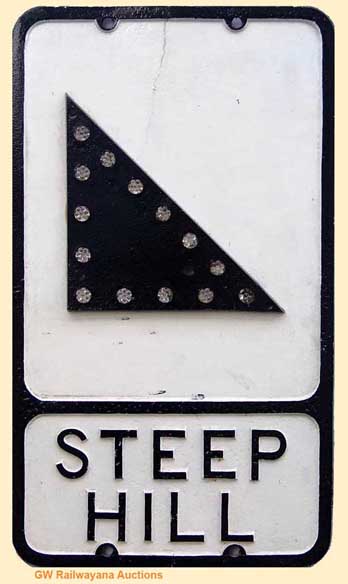 wide open spaces of Shap - and nothing could have dissuaded me; not even the chance of photographing a hard working steam locomotive doing battle with the four miles of 1 in 75 to the summit. A rare glimpse of sunshine gave me the chance to photographed some of the engines in residence on shed at Tebay - three Fowler Class 4MT 2-6-4s, Nos 42396, 42404, 42424, all having side windows fitted to the cab to protect the crew from the wintry conditions during banking duty to the summit. The rest was made up of 4 Ivatt LMS 2-6-0s Nos 43011, 43018, 43029 and 43035 and a solitary Standard Class 2MT No 78013. But shed-bashing wasn't the main item on the agenda; the distant craggy ridges of the Lune Valley looked a more inviting place. I suppose one can wax lyrical on such a beautiful spot: the gurgling notes of the Lune river tumbling through the valley, the steep escapement of the surrounding fells, the wind in the telephone wires, the call of the curlew, and the distant bleating of sheep - yes, the valley was a beautiful place in the days before the six-lane M6 Motorway ruined it, but on that eventful April day the grey ceiling of clouds brewing over the fells was ample warning of what was to come
wide open spaces of Shap - and nothing could have dissuaded me; not even the chance of photographing a hard working steam locomotive doing battle with the four miles of 1 in 75 to the summit. A rare glimpse of sunshine gave me the chance to photographed some of the engines in residence on shed at Tebay - three Fowler Class 4MT 2-6-4s, Nos 42396, 42404, 42424, all having side windows fitted to the cab to protect the crew from the wintry conditions during banking duty to the summit. The rest was made up of 4 Ivatt LMS 2-6-0s Nos 43011, 43018, 43029 and 43035 and a solitary Standard Class 2MT No 78013. But shed-bashing wasn't the main item on the agenda; the distant craggy ridges of the Lune Valley looked a more inviting place. I suppose one can wax lyrical on such a beautiful spot: the gurgling notes of the Lune river tumbling through the valley, the steep escapement of the surrounding fells, the wind in the telephone wires, the call of the curlew, and the distant bleating of sheep - yes, the valley was a beautiful place in the days before the six-lane M6 Motorway ruined it, but on that eventful April day the grey ceiling of clouds brewing over the fells was ample warning of what was to come
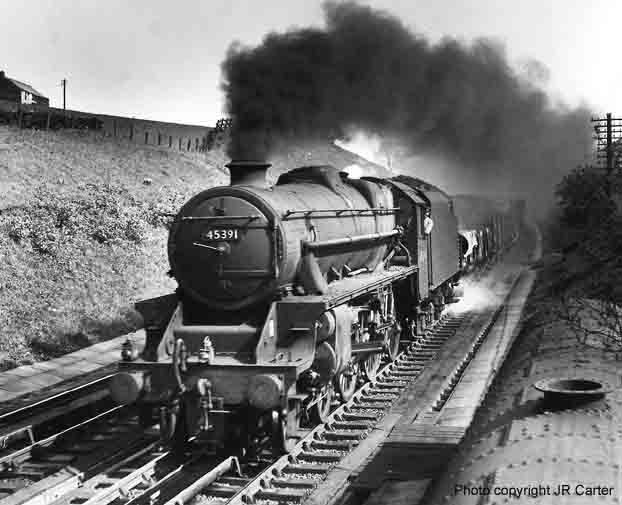
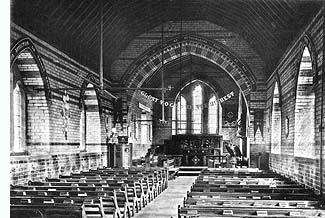
TEBAY RAILWAY PHOTOS SOUGHT: David Aspden recently contacted the site seeking railway photographs of Tebay taken before 1965 of the stretch of line from the Fairmile to Scout Green - especially those of the station. David is connected with the St James' Church in Tebay, which was built by the railway in the 1880s. He writes: 'The church attendances have fallen over the last few years and our Vicar is looking at using the rear of the church to put on a permanent exhibition of Tebay's railway history. There are still a few retired railway employees living in Tebay and one gentleman has collected local photographs to help illustrate talks about the railway around Tebay in the 1950s. I have attached an old photo of our church, which you will notice has many railway features incorporated in its design. My reason for contacting you is to promote the church to the many visitors who come to take photos on the occasion of a steam special on the WCML. The idea is to put on a photographic exhibition, and we are seeking photographs taken before 1965 along the stretch of line from the Fairmile to Scout Green - especially those of the station. I do hope your site visitors can help us with this project. My email address is david@thepines25.plus.com Many thanks in anticipation. Regards, David Aspden
(Above) Banking engines wait their next turn of duty inside Tebay shed on 27 September 1967. The former LNWR steam shed was rebuilt into a modern 4-road concrete structure immediately after nationalisation in 1948. Tebay (11D - a sub shed to Barrow 11A) came under the auspices of Carlisle Kingmoor (12A) from May 1960 onwards and the code was changed to 12H. During the final years of steam the unlawful removal of nameplates, number and shed code plates by souvenir hunters became all too common, hence both shed and number of BR Standard 4MT No 75026 have been painted on the smokebox door. Perhaps BR shed staff removed them as a precaution against pilfering, or had someone beaten them to it? On the left is Fairburn 2-6-4T No 42134. Photo copyright ED Burdon.
(Below) Former Guildford railwayman, Dave Salmon, best known by work colleagues for his passion for photography, sadly passed away aged 78 in July 2015. Dave bequeathed his photographic archive to fellow railwayman, Geoff Burch - see pages 32-37 - who has generously allowed reproduction of 3 photographs of Tebay station and shed which were taken by Dave during a Carlisle Rail Tour on 22nd January 1968. The station had three platforms with goods facilities on the east side of the line including a goods shed and cattle dock; the goods facilities were withdrawn on 2 March 1964 and following closure of the station on 1 July 1968, the buildings and platforms were demolished in the early 1970s and no trace of it now remains.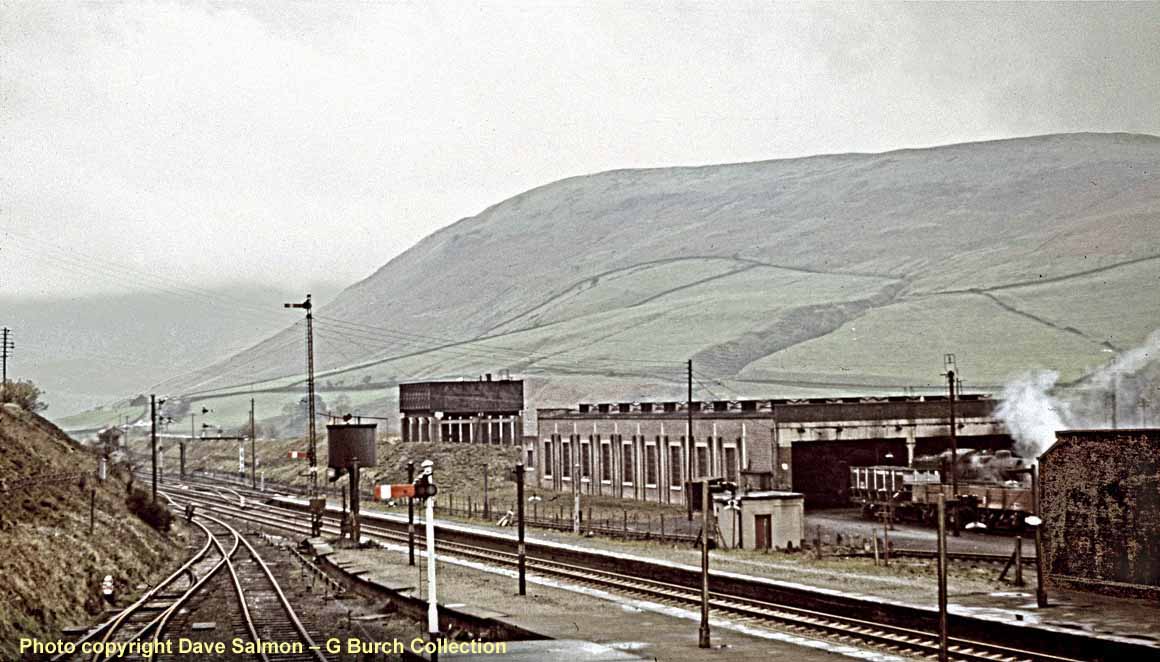
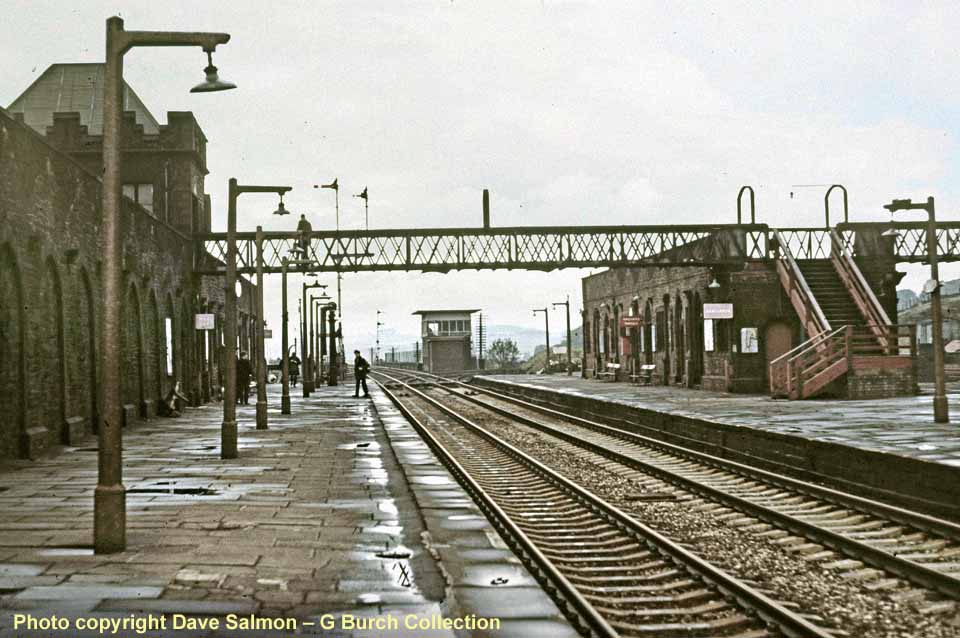
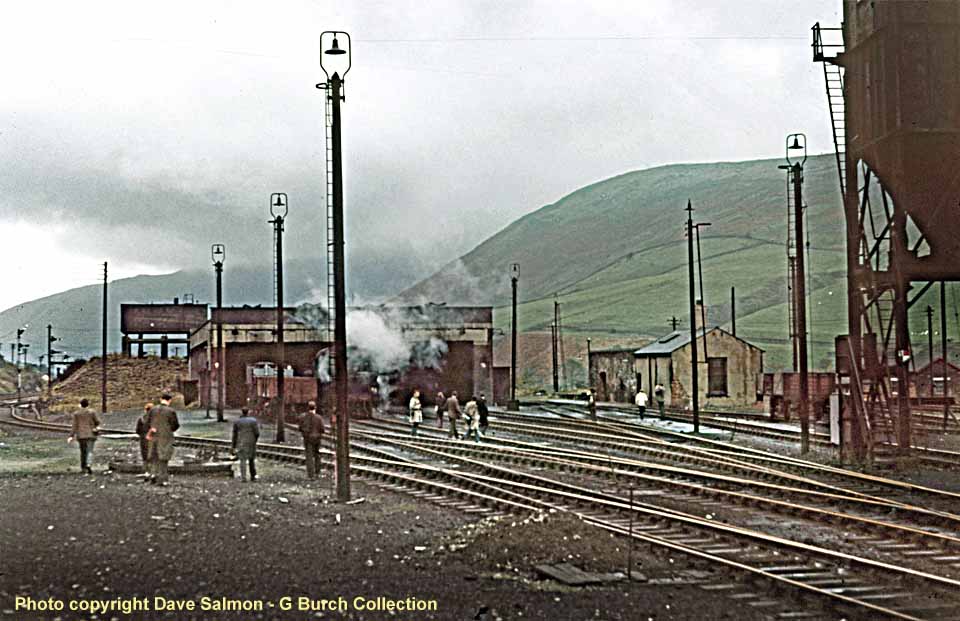
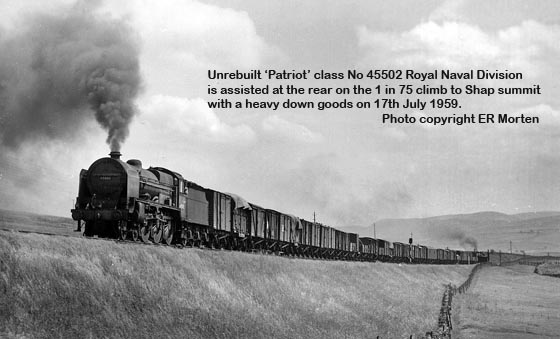
(Above-Below) For those who enjoy the great outdoors, there is no wilder place than the southern slopes of Shap Fell. This bleak and forlorn stretch of moorland is one of howling winds and horizontal rainfalls, where only ragged sheep and railway photographers might roam. (Below) Sporting its obligatory 25kV warning stripe on the cab side, rebuilt 'Patriot' class No 45527 Southport heads a northbound freight up the 1 in 75 bank from Tebay in April 1964. Photo © B Lister
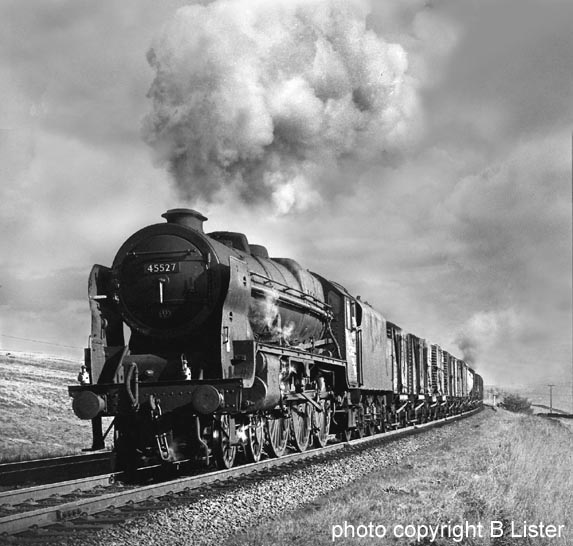
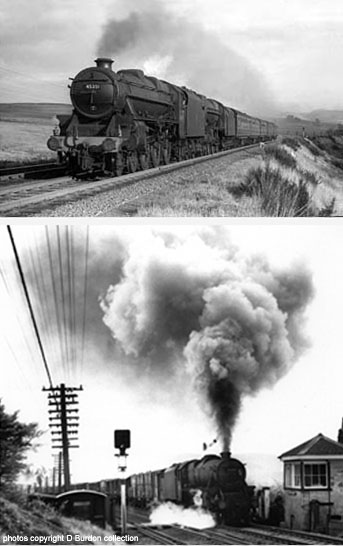 | 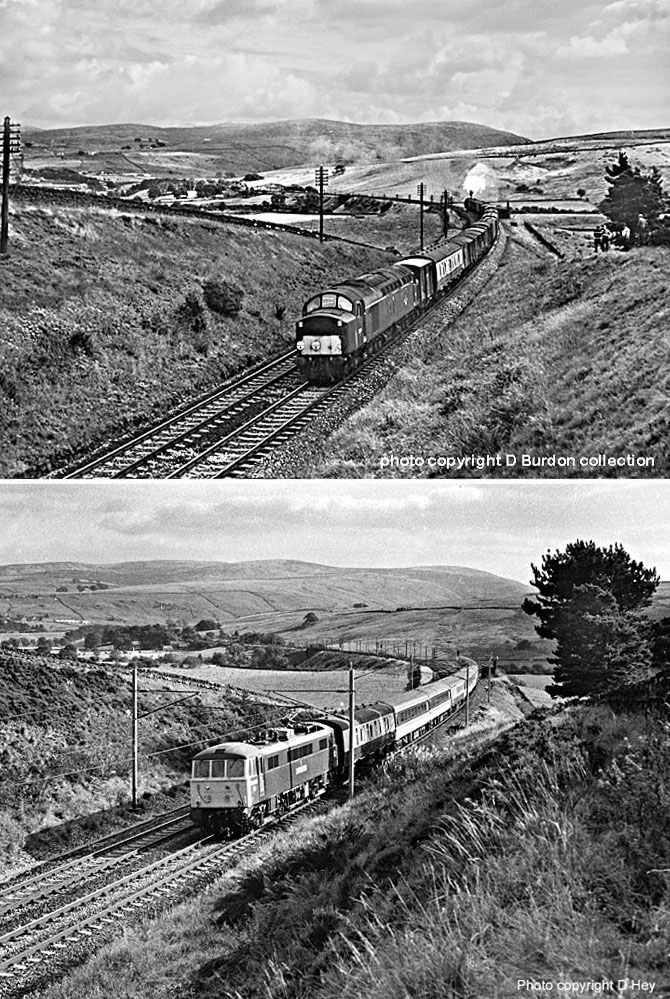 |
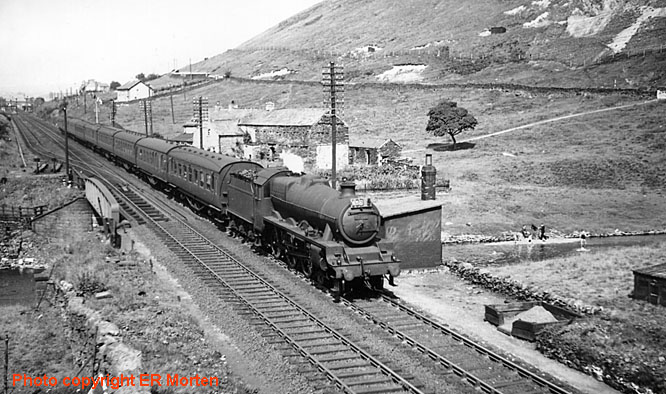
(Above-Below) Messing about on the river! A group of youngsters splash about in the infant River Lune as 'Jubilee' class No 45571 South Africa heads south from Tebay on 20th August 1939. (Below Left) A classic JR Carter shot of 46250 City of Lichfield tackling Shap Bank at Greenholme.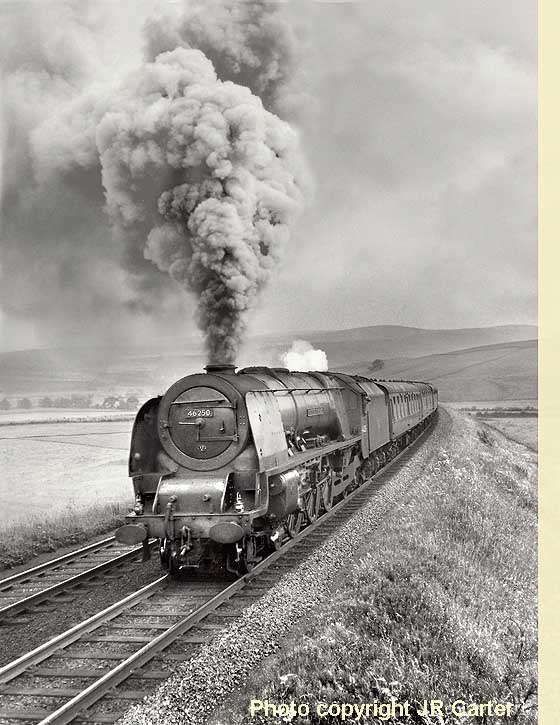 Can anyone help? John Bateson recently contacted the site seeking a photo of 'Jubilee' class 45571 South Africa for private use at his home in South Africa. John writes: 'I enjoyed viewing the railway photos of Tebay, Shap and the Lune Valley. Now 74 years of age, I am of an era when those locos, both steam and diesel, were there to be spotted by young boys lucky enough to get trackside on the LMS route and, in particular, north of Preston.
Can anyone help? John Bateson recently contacted the site seeking a photo of 'Jubilee' class 45571 South Africa for private use at his home in South Africa. John writes: 'I enjoyed viewing the railway photos of Tebay, Shap and the Lune Valley. Now 74 years of age, I am of an era when those locos, both steam and diesel, were there to be spotted by young boys lucky enough to get trackside on the LMS route and, in particular, north of Preston.
As a youngster, I would cycle from my home in Thornton to Brock on the London-Glasgow main line, in order to enjoy the sights and sounds of these wonderful engines in their multi-coloured livery. In wet weather, and breaking all the rules, we would slide down the embankment to shelter under the rail over-bridge just a few yards up the lane from the Roebuck pub on the A6. Many is the time we had to judge which train would pass first, as we would stand against the opposite abutment to the oncoming train, then dart across the tracks to the other side, before the next one passed in the other direction.
Some years later, I found myself working in the Lancaster District Engineer's office as a draughtsman - engineer, where a license to get up close and fairly personal with the tracks was mine by right. As you will know, the Lancaster District covered the West Coast main line from Preston to Gretna, together with the Settle to Carlisle line, and all the branch lines west of these two routes. My work took me to all corners of the district by train, by loco and by car. My duties included taking mouldings of tracks in the tunnels (to establish rail cross-sectional area lost due to wear and corrosion) and which of course included the S&C and branches. Kneeling in the tunnel cess clutching a duffel coat tightly around me, as a high speed steam train hurtled past, was an experience I'll never forget. The Tebay link was a drawcard - if my duties took me there for engineering 'surveys' at Shap summit, I sometimes used scheduled passenger train to/from Tebay, then jumped a working banking engine there and back. If I was really lucky, the local Tebay Ganger would 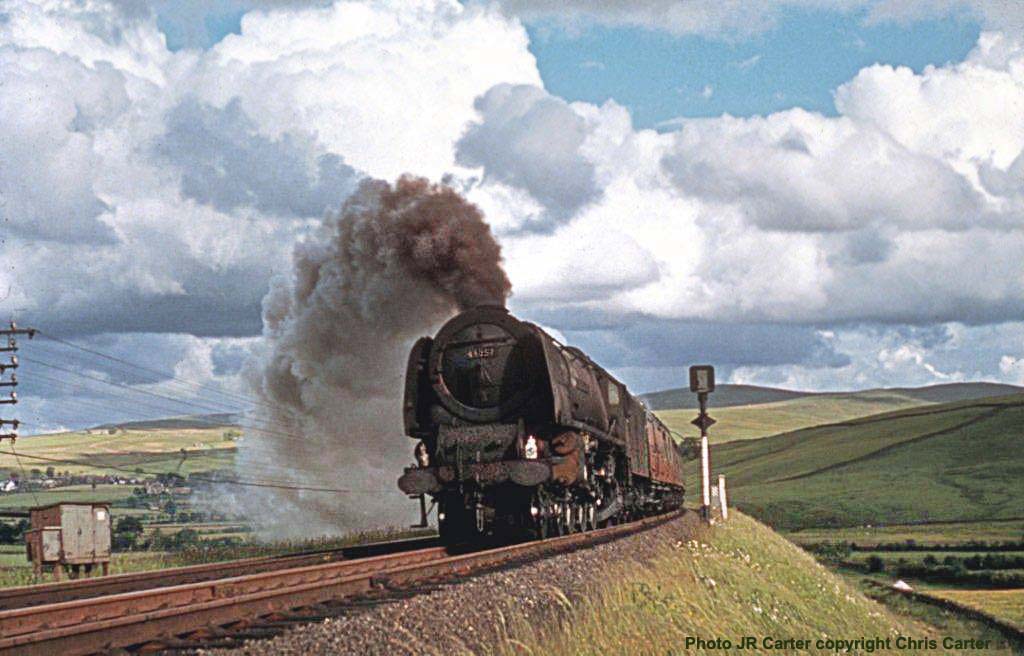 sometimes 'donate' a fresh Lune salmon - all legal and above board of course!...'
sometimes 'donate' a fresh Lune salmon - all legal and above board of course!...'
Now retired John is living in the Eastern Cape village of Alicedale, South Africa, if anyone can help with a photo of 45571 it will be much appreciated. John's email address is: myjabulani1@vodamail.co.za
(Right-Below) Another JRC study of steam days on Shap; 46257 City of Salford tackles the 1 in 75 climb to the summit. (Below) During the transition from steam, the EE Co Type 4s will always be associated with the West Coast route, often struggling with 13 coaches on the drawbar and hammering the locomotive with a load for which it was not designed. With the absence of a smoke effect (an integral part of steam railway photography) the anomaly about photographing diesels is the sense that the subject is standing still, yet one can almost hear 16-cylinders of engines bellowing out as No D382 struggles up the 1 in 75 climb at Greenholme with a Euston-Perth express. Both classic Jim Carter photos...
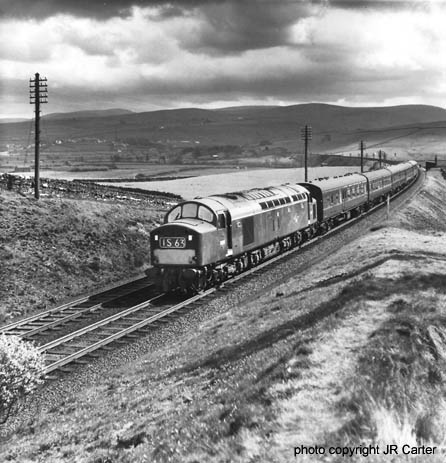
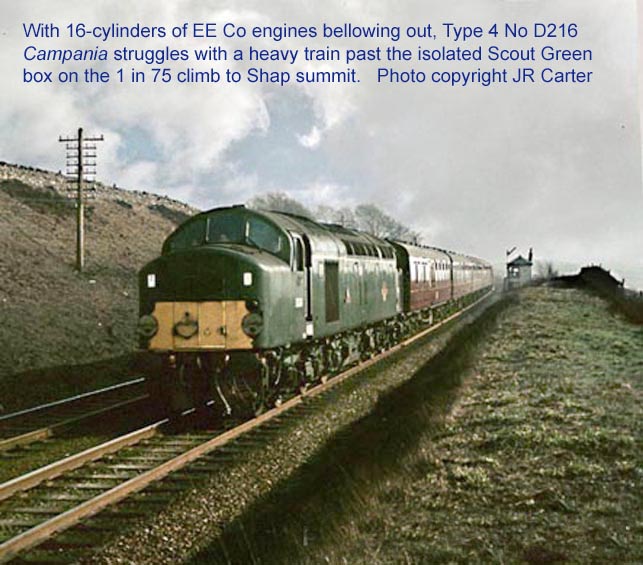
(Below) The BTC's diesel age took off in 1957 when the newly-built EE Co pilot scheme Type 1 diesels (the first to be delivered in the pilot-scheme orders) were being put through their paces on two test runs from the Vulcan Foundry. The first involved hauling a brake van (stabled at the EE Co works specifically for the purpose) to Chester. Any faults were rectified overnight in readiness for the second test (hauling a rake of ex-LMS vehicles) from Edge Hill via Preston to Penrith on the WCML. Although Shap summit - at an altitude of 915ft above sea level - provided a severe haulage task for a 1,000hp locomotive, on no account was banking assistance allowed. Here, newly-built Type 1 No D8003 leans to the curve at Low Gill station with the northbound train in August 1957. In that same year, the Soviet Union launched the world's first satellite (Sputnik) into orbit - the Space Race had arrived too. Photo © GEC/Alstom
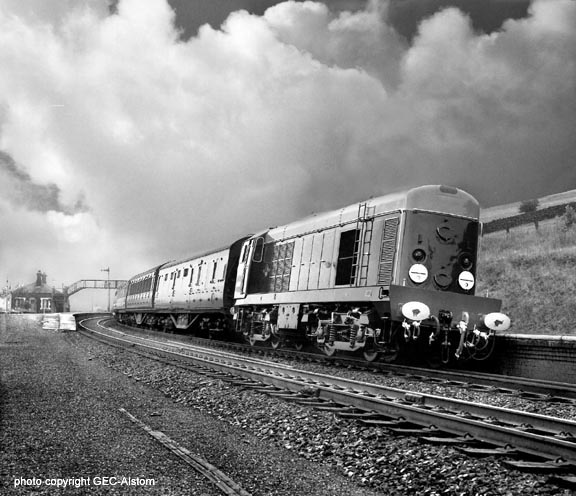
With only a flimsy anorak for protection, I set off south from the village, ignoring the distant rumble of thunder. Then, just before reaching the road bridge near Dillicar troughs the deluge started - more of a cloud burst than anything else - then all the denizens of hell seemed to break loose: hailstones, lightning, howling winds. It whipped up into a frenzy. I sheltered against a dry stone wall and waited half an hour - an hour? - I'd lost all track of time. A couple of trains went by, perhaps three - I didn't even bother to look. I was soaked to the skin, frozen to the bone...I ached in every muscle, in every sinew. I desperately wanted to go home.
Then, all at once, it stopped, - as if a tap had been turned off - and just as quickly the sun broke through, and for the first time that day I could enjoy the Lune Valley in all its glory. The silence was a humbling experience; a magical place to spend a lazy afternoon taking photographs of trains at various locations along the line.
I'll never forget the thrill of hearing the four-beat exhaust of a hard working Stanier Pacific from somewhere beyond Low Gill. Then I saw the distinctive tartan headboard above the smokebox door. This was it!...a dream come true - a chance to photograph a 'Duchess' on the 'Royal Scot' express at the very same spot that Eric Treacy probably did many years ago.
I snatched the lens cap off, checked the aperture, shutter and focus. Had I wound on the film? Check again - now steady, steady...a deep breath, aim...fire! It happens so quickly, there is barely any time to enjoy the moment until it is too late and the Duchess is heading away towards Tebay, followed by the leisurely clickety-clack of carriage wheels over rail joints and the timeless sounds of nature envelopes the valley again. Memories? How long ago it all now seems...
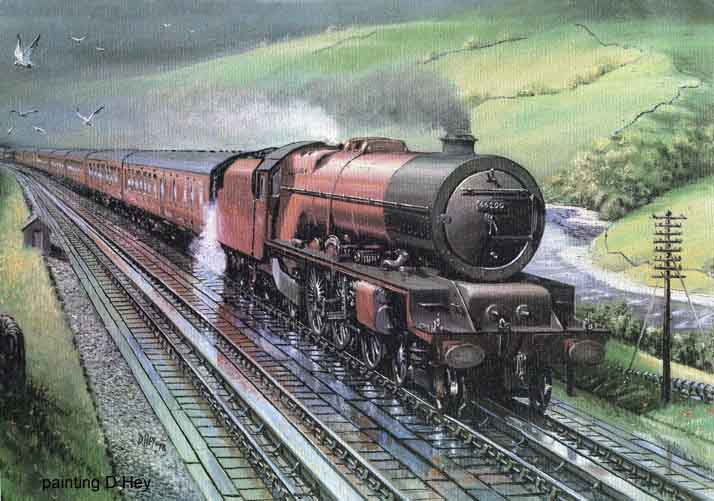
By four o'clock in the afternoon, I had taken twenty shots out of twenty four, so I headed back to Tebay and finished off the remainder of the film in the shed yard before the light went. It wasn't until the train was heading back to Leeds, that I took the camera out of its leather case and rewound the exposed film back into the cassette. Of course, unloading a film is an easy enough task in the normal way, and one I had done countless times before - but when the rewind handle suddenly slackened off, my heart sank. Instead of the familiar resistant sound of celluloid passing from one sprocket to the other, the camera gave out an ominous 'plop!' almost as if the film had wound back instantly...
It was my worst nightmare. Either I had fed the leader (the length of trimmed film) into the fixed spool incorrectly, or the sprocket wheels (used for advancing the film to the next frame) had come loose, or jammed, or else…
Or else what?
Truth is I could juggle with all manner of excuses, shake off all the imponderables, but this wasn't a simple 'either and or' situation. On closer inspection, I found bits of chewed-up celluloid inside the back of the camera and, without thinking, stormed off down the corridor in a fit of temper, opened the window and came to within an inch of hurling the wasted cassette into a field somewhere between Hellified and Bell Busk - when it suddenly struck me that maybe - just maybe - there was something on the film after all?
Of course, one hour processing was unheard of in those days, so I had to wait a whole week to find out. Sure enough, on collecting the pictures from the chemist, there wasn't a single print - and on examining the negatives against the light, apart from a jumbled mass of super-imposed images over the first frame, the rest of the film was blank...
Needless to say, I was inconsolable for weeks afterwards, but it wasn't the end of my misery. By the end of the year, BR's stock of steam locomotives had dwindled to 13,244, including 596 in store, 240 of them unserviceable. At the same time, the Calder Valley sets and Trans-Pennine units were introduced in the north of England, together with 409 main line diesel locomotives nationwide, which brought the total available to 842, yet the proportion of diesels out of action or awaiting attention was no better than the availability of steam. Even so, there was a sense that time was running out fast for steam. By the end of 1964, there were just 4,970 steam locomotives left…less than five thousand? It was a statistic much lamented by adult enthusiasts, and the hobby would never be the same again...
(Below) Surely, every photographer's nightmare? Out of 24 shots I took on my visit to the Lune Valley, this is the only discerible image (if you can call it that?) of 'Coronation' class No 46254 City of Stoke-on-Trent heading the northbound 'Royal Scot'. As for the rest of the trains? They're all in there somewhere. Perhaps in the future, time permitting, I can salvage it in Adobe Photoshop and remove the layers one by one?...
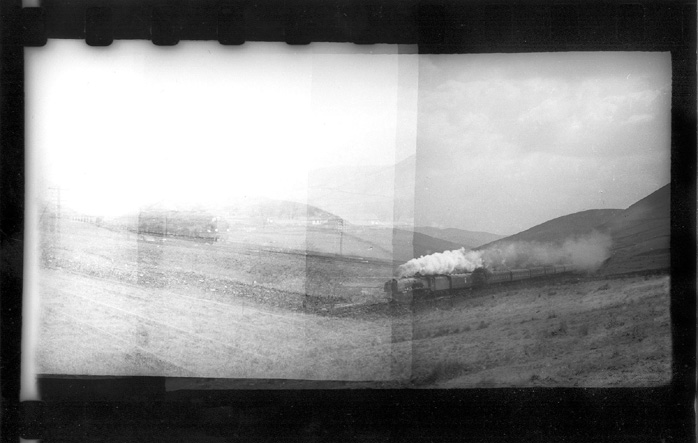
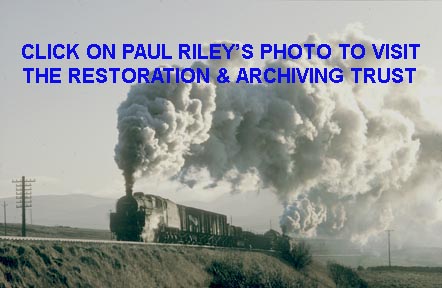 (Left) A classic Paul Riley shot of a Standard 5MT on Shap bank. I do recommend visiting the excellent website of 'The Restoration & Archive Trust'. The primary objective of the Trust is to provide museum type facilities on the Gloucester & Warwickshire Railway and develop an archive of railway photographs that is worldwide in scope. Browsing this site is a joy! You'll find a lovely piece written by Ian Krause and an autobiography written by Derek Huntriss in which both men pay tribute to fellow photographer Paul Riley 1945-1976. Click on photo to visit the site.
(Left) A classic Paul Riley shot of a Standard 5MT on Shap bank. I do recommend visiting the excellent website of 'The Restoration & Archive Trust'. The primary objective of the Trust is to provide museum type facilities on the Gloucester & Warwickshire Railway and develop an archive of railway photographs that is worldwide in scope. Browsing this site is a joy! You'll find a lovely piece written by Ian Krause and an autobiography written by Derek Huntriss in which both men pay tribute to fellow photographer Paul Riley 1945-1976. Click on photo to visit the site.
(Below) I never thought I'd get a second bite at the cherry, but the following year BR ran another Ramblers Excursion to Tebay. This time I was armed with an Agfa Sillette 35mm camera, but with slow film speeds and inaccurate guesses on f- stops, railway photography was still a hit and miss affair, and shots of fast moving trains were usually avoided. However, if it looked good in the viewfinder, then it was always worth taking a chance. This shot of 'Coronation' class No 46238 City of Carlisle was a case in point. The engine is scooping more than enough water from Dillicar troughs in May 1961. Barry Tate recently pointed me in the direction of some fabulous vintage footage of steam between Grayrigg Bank and Shap, including action shots of locos picking up on Dillicar Trough, I do recommend visiting RailMon's superb upload on YouTube..ten minutes of pure nostalgia!
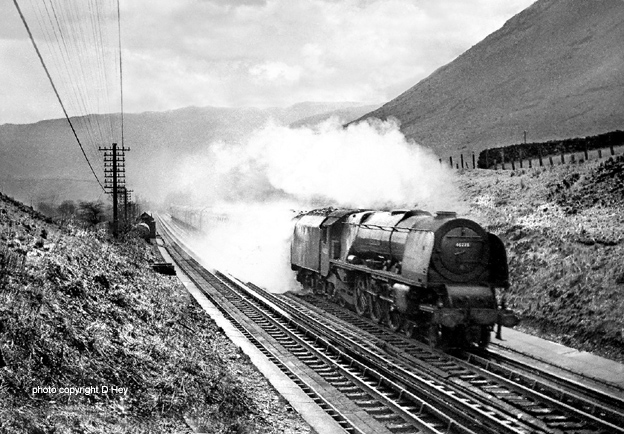
(Above-Below) Whilst the Beeching cuts and steam's demise came as a body blow to enthusiasts during the Sixties, there was also a sense that Britain was no longer the world power of old. Hardly a year went by without a member of the Royal Family saluting a new flag in Asia or Africa. A poignant reminder of this nation's once great past can be found among the names of the Commonwealth countries listed in the 'Jubilee' class 4-6-0s. Here, No 45553 Canada heads a southbound train over Dillicar troughs. Photo © D Hey
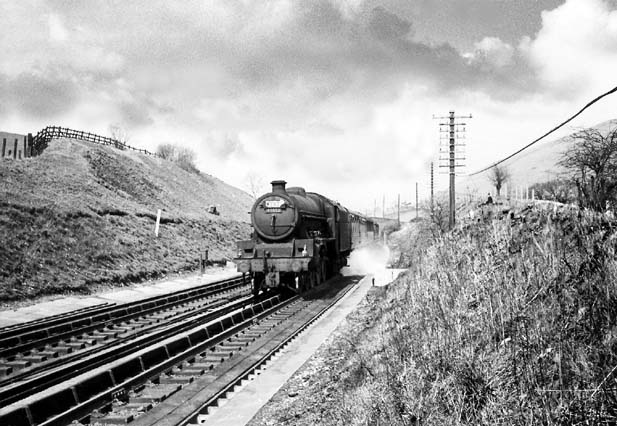

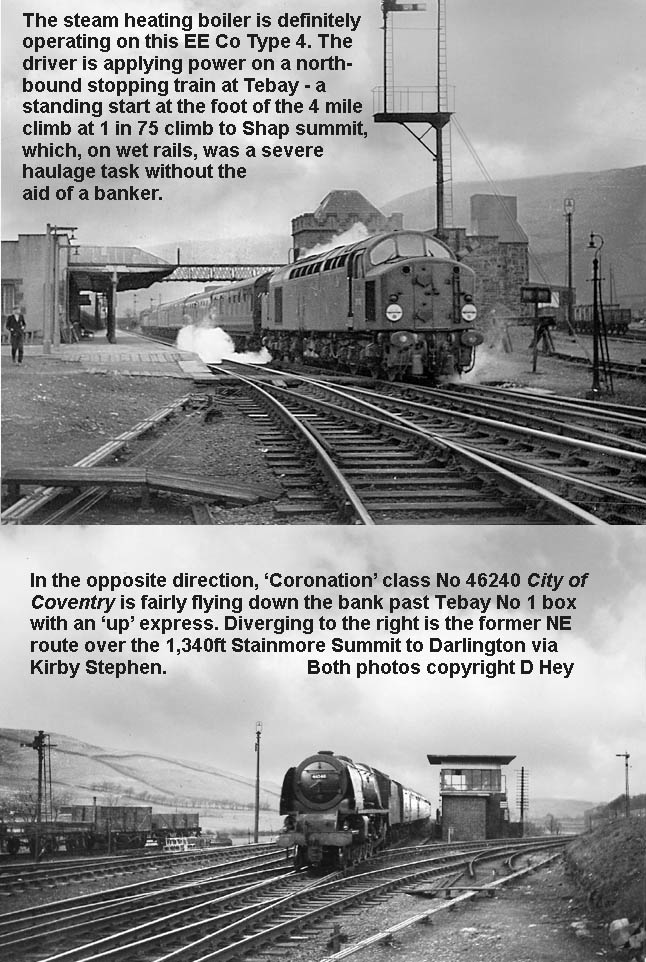
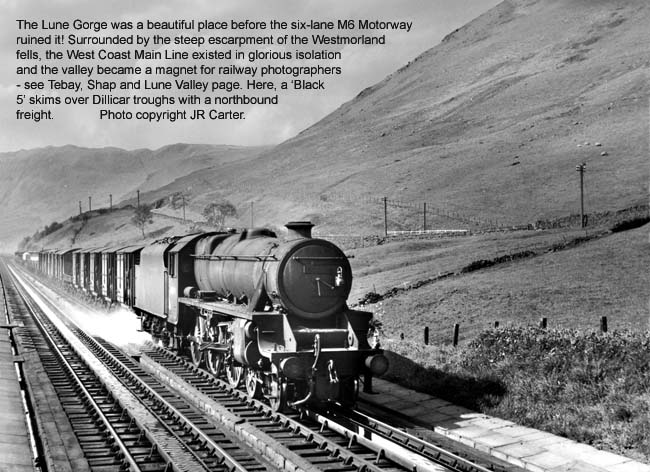
(Right-Below) Let me be quite honest about this, if you can have sexy cooking, sexy football and sexy sports cars - then why not sexy locomotives? What a difference a livery makes - the streamlined 'Coronations' musk rank as being the sexiest locomotives of all! The first 5 LMSR streamlined Duchesses 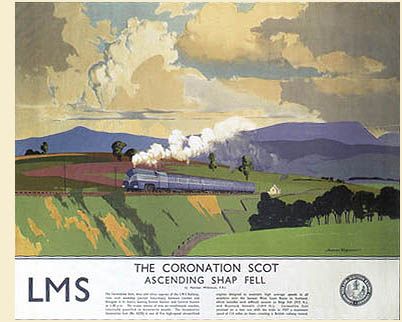 emerged from Crewe Works in Prussian Blue with silver body-length speed stripes, followed by a further fifteen in a striking Midland Red with gold stripes. It enhanced their appearance extremely well, but with the imposition of wartime stringencies the last four streamliners received a dull overall black livery. Eventually all the streamliners received the same treatment, which made them look rather ordinary in comparison. But then, beauty is in the eye of the beholder, they say, and British artist, Norman Wilkinson RI (1878-1971) certainly captured the majesty of steam in the Cumbrian Fells (right). The artist began his career as an illustrator with the Illustrated London News and went on to design posters for the LNWR, LMS and SR. He also worked with the British Admiralty designing dazzle camouflage for British ships during World War One. This artwork for a London Midland & Scottish Railway poster shows the northbound 'Coronation Scot' ascending Shap. The Coronation Scot had a journey time of 6½ hours between London and Glasgow, and during test runs in 1927 the LMS broke a British railway record achieving a maximum speed of 114 mph. The artist's flamboyant style appeared on many railway posters, many of which can be found on the excellent NMSI Collections Online...a visit is highly recommended. (Below) The first of class, No 6220 Coronation, heads the 'down' 'Coronation Scot' up Shap Bank in August 1939. Photo © K Todd collection.
emerged from Crewe Works in Prussian Blue with silver body-length speed stripes, followed by a further fifteen in a striking Midland Red with gold stripes. It enhanced their appearance extremely well, but with the imposition of wartime stringencies the last four streamliners received a dull overall black livery. Eventually all the streamliners received the same treatment, which made them look rather ordinary in comparison. But then, beauty is in the eye of the beholder, they say, and British artist, Norman Wilkinson RI (1878-1971) certainly captured the majesty of steam in the Cumbrian Fells (right). The artist began his career as an illustrator with the Illustrated London News and went on to design posters for the LNWR, LMS and SR. He also worked with the British Admiralty designing dazzle camouflage for British ships during World War One. This artwork for a London Midland & Scottish Railway poster shows the northbound 'Coronation Scot' ascending Shap. The Coronation Scot had a journey time of 6½ hours between London and Glasgow, and during test runs in 1927 the LMS broke a British railway record achieving a maximum speed of 114 mph. The artist's flamboyant style appeared on many railway posters, many of which can be found on the excellent NMSI Collections Online...a visit is highly recommended. (Below) The first of class, No 6220 Coronation, heads the 'down' 'Coronation Scot' up Shap Bank in August 1939. Photo © K Todd collection.
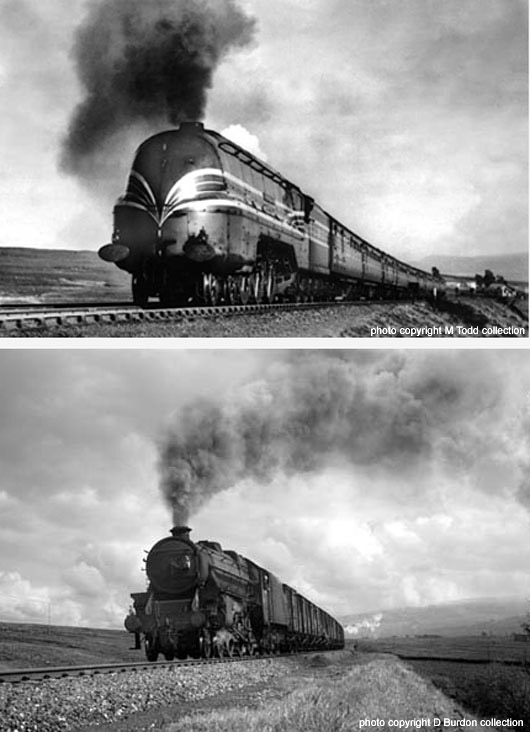
(Above-Below) Lovely shot of an unidentified 'Black 5' being banked up the 1-in 75 incline near Shap Wells. (Below) Another pair of cracking photos from the Dave Burdon stable - 'Britannia' class No 70045 Lord Rowallan coast down the bank with a mixed freight. In the opposite direction, No 70039 Sir Christopher Wren does battle with the 1 in 75 grade at Shap Wells. Both © D Burdon collection
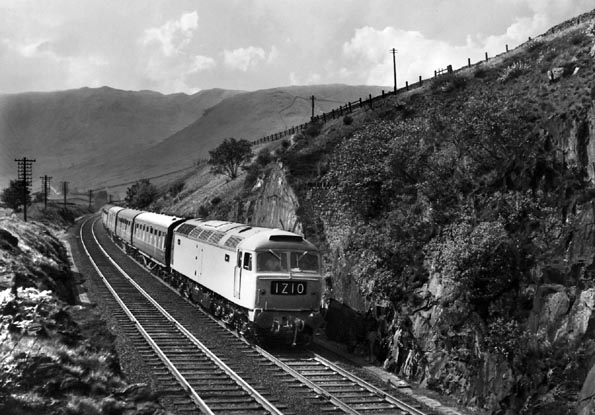
(Above) In 1962, Brush Traction was awarded the contract for BR's second-generation Type 4, but as the company did not have the capacity to construct sufficient numbers to meet delivery targets, an agreement was made with the BR Crewe workshops to construct some of the locomotives under licence. A familiar sight on the WCML was the 1Z10 northbound test train and 1T94 return to Crewe, when conditional paths were made available between Crewe and Carlisle for testing new diesels built either at Crewe or the English Electric Co works at Newton-le-Willows. Still in grey undercoat, this Crewe-built Brush Type 4 displays 1Z10 in its four panel route indicator as it heads the northbound test train through the Lune Gorge. Photo © JR Carter
(Below) In the opposite direction, EE Co Type 4 No D233 heads a southbound train away from Dillicar troughs. Surprisingly, the EE Co Type 4's (Class 40s) reign on the Anglo-Scottish service north of Crewe was not greatly effected by the more powerful 2,750hp Brush Type 4s, even though the extra 750hp made all the difference, particularly in the northern fells where speeds of 50mph could be regularly maintained on the climb over Shap. It was a significant improvement on the EE Co Type 4s which laboured at crawling pace over the summit. However, the LMR prefered reliability and familiarity in the maintenance of their EE Co machines, and it was not until the arrival of EE Co D400s in 1968 that the Class 40's reign was seriously effected north of Crewe. Photo © D Hey

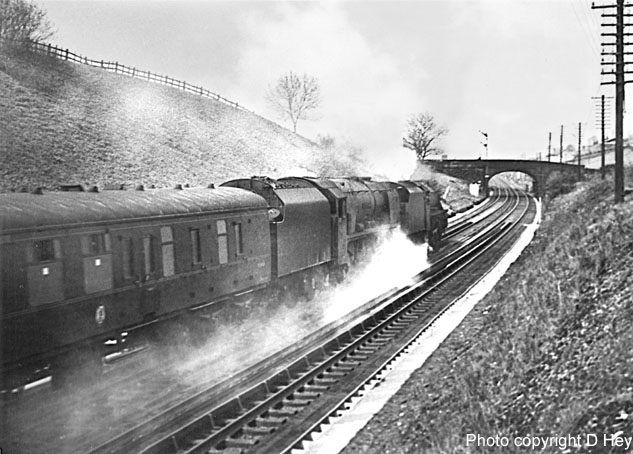 |  |
Polite notice: All text and photographs are protected by copyright and reproduction is prohibited without the prior consent of the © owners. If you wish to discuss using the contents of this page the email address is below. Please note - this is not a 'clickable mail-to link via Outlook Express:
dheycollection@ntlworld.com

